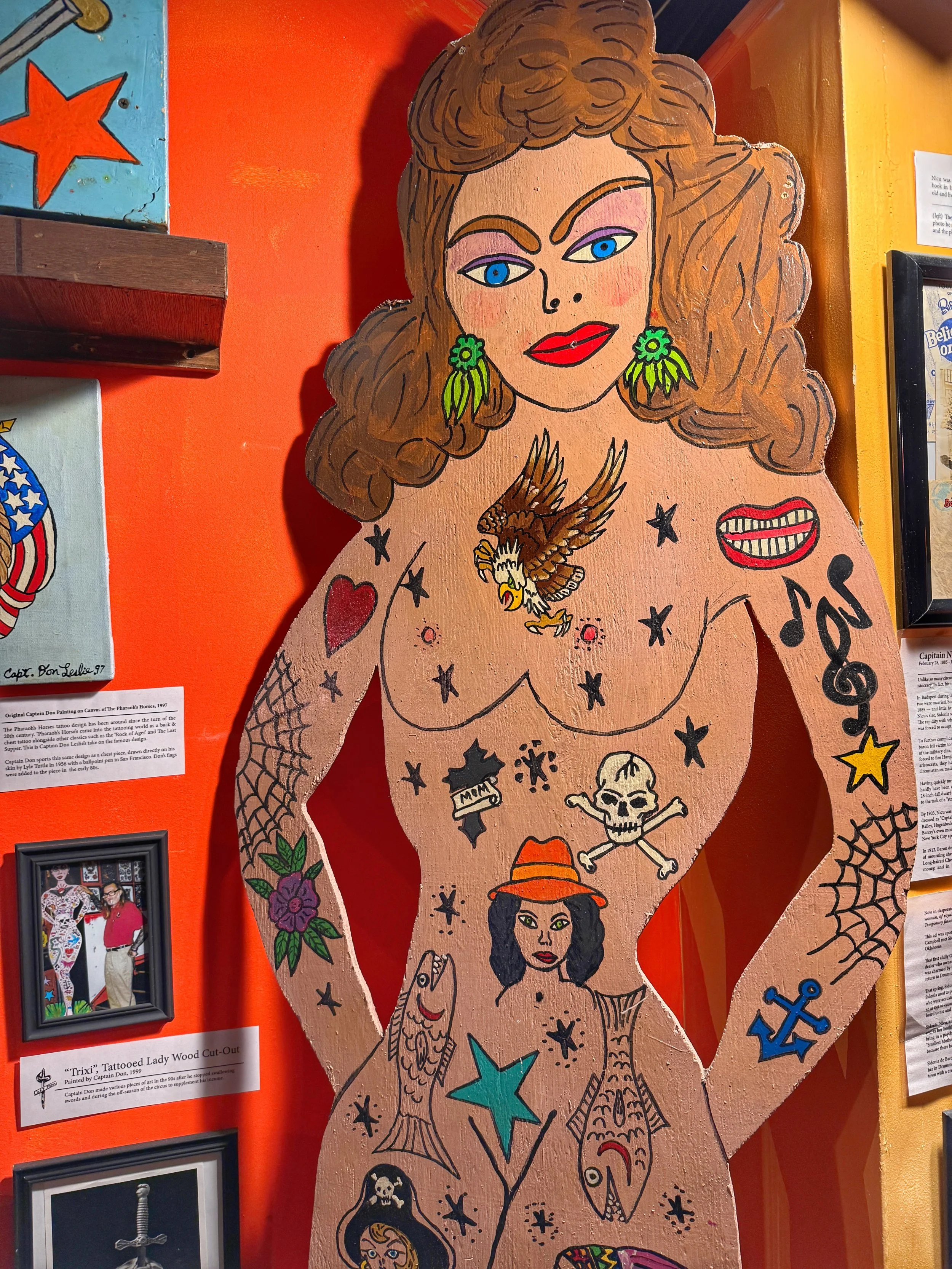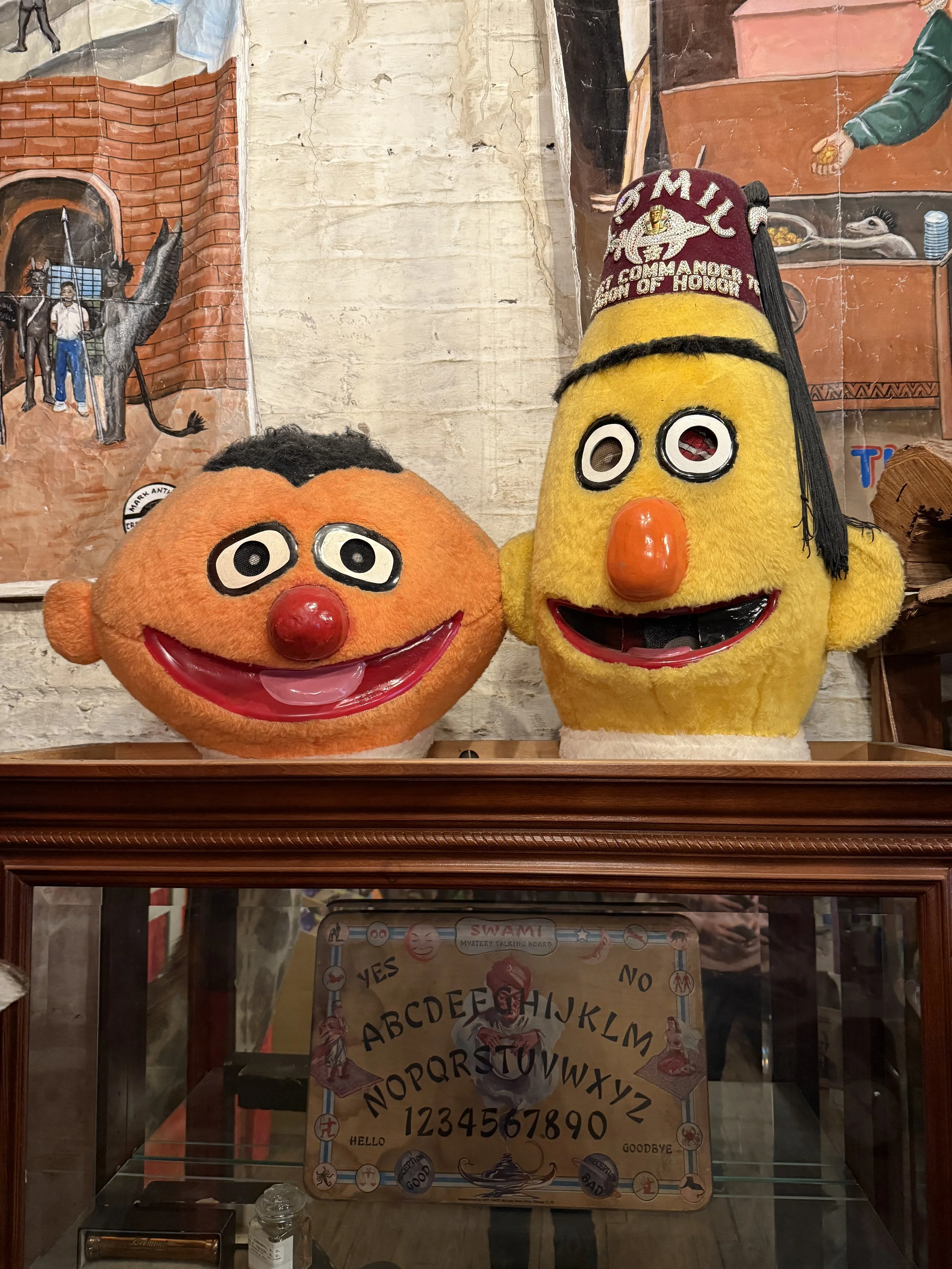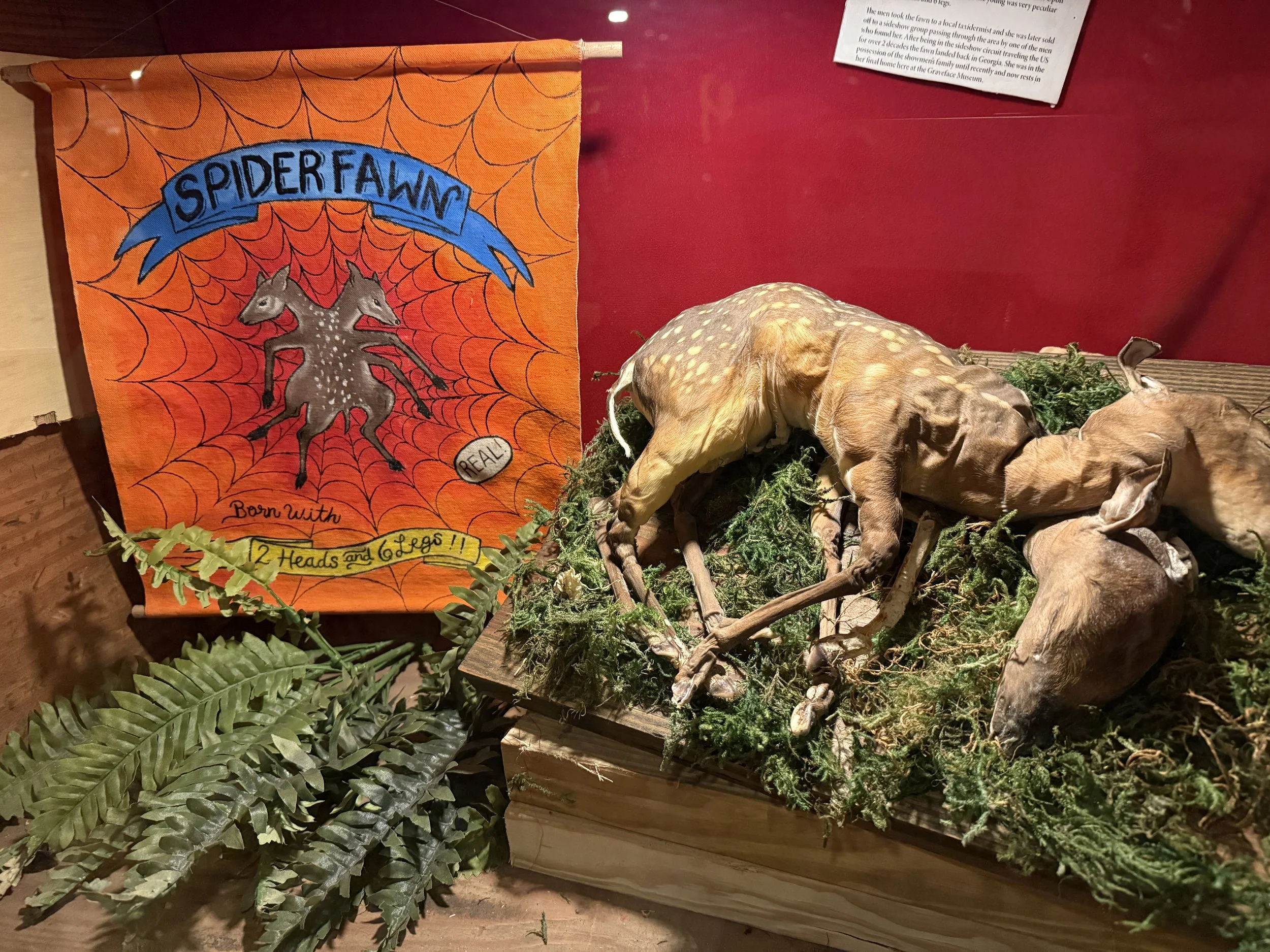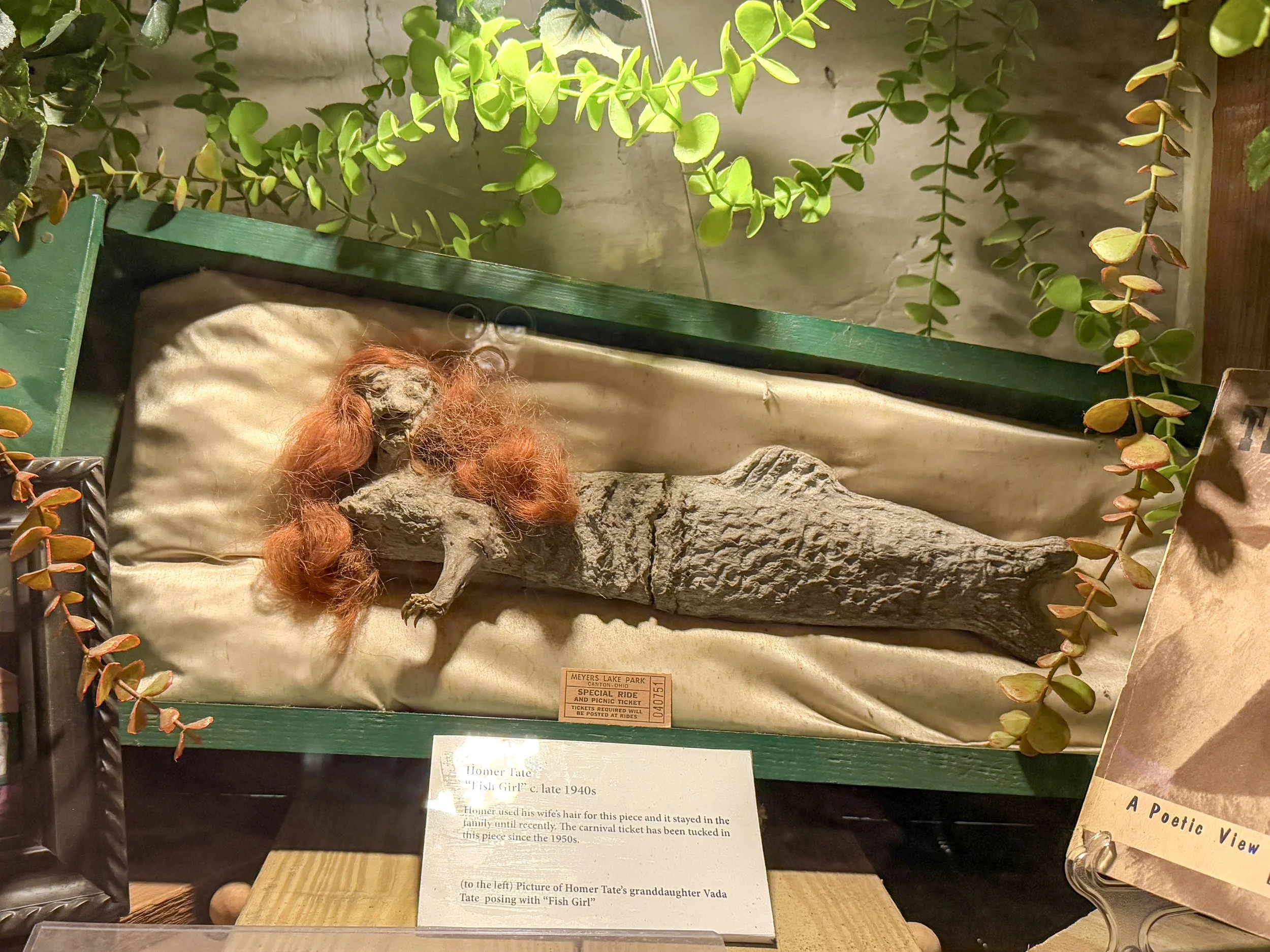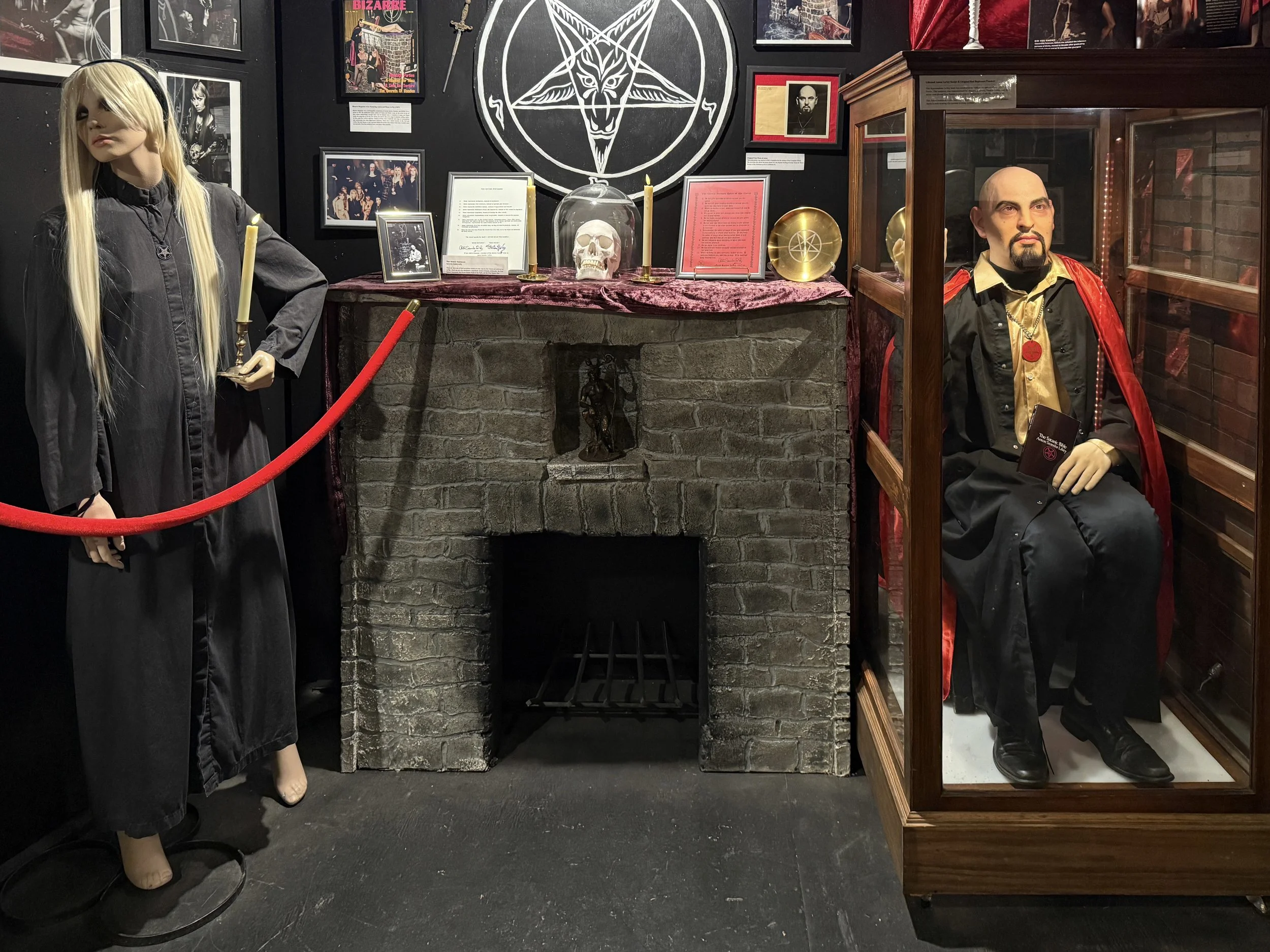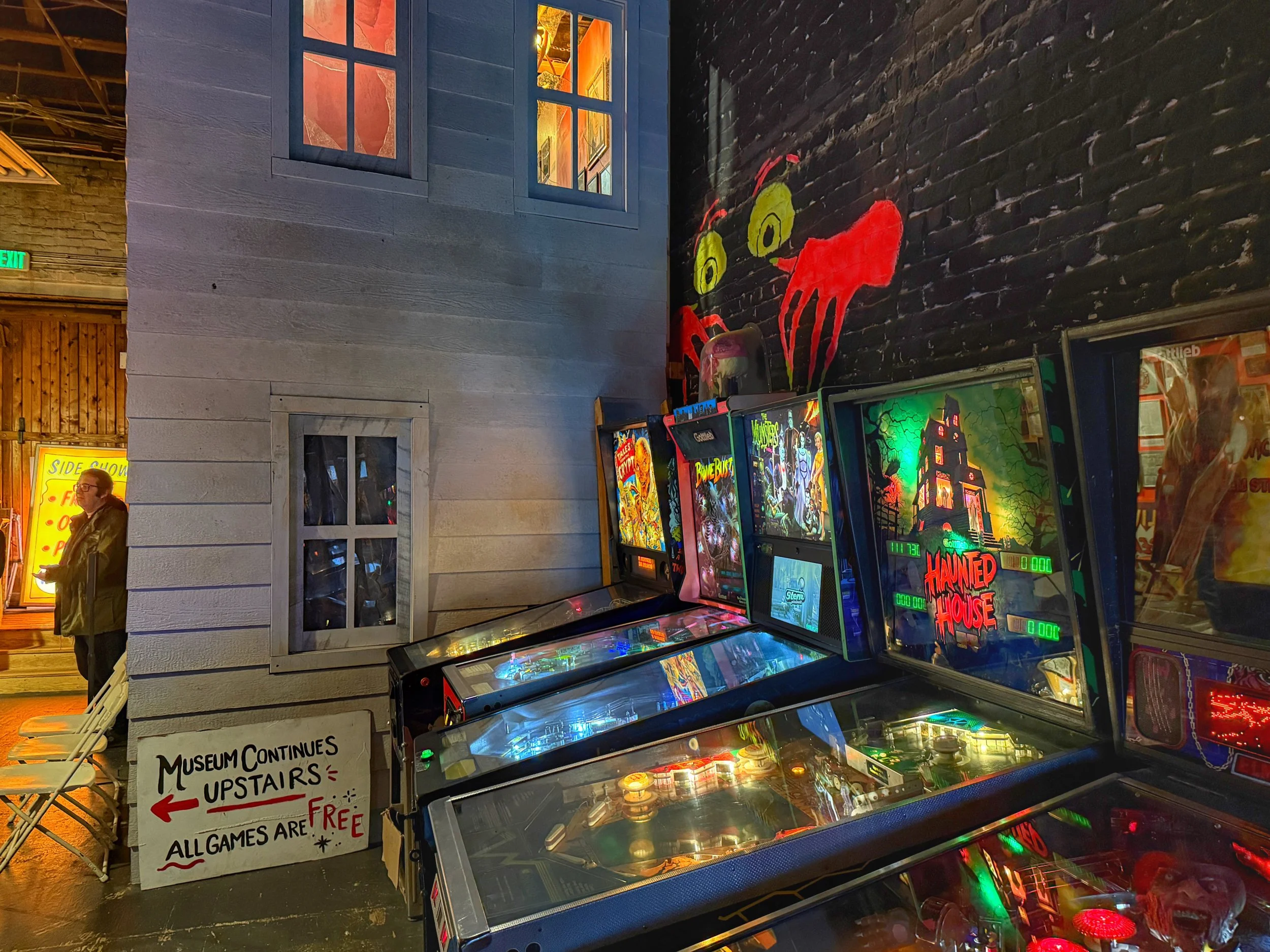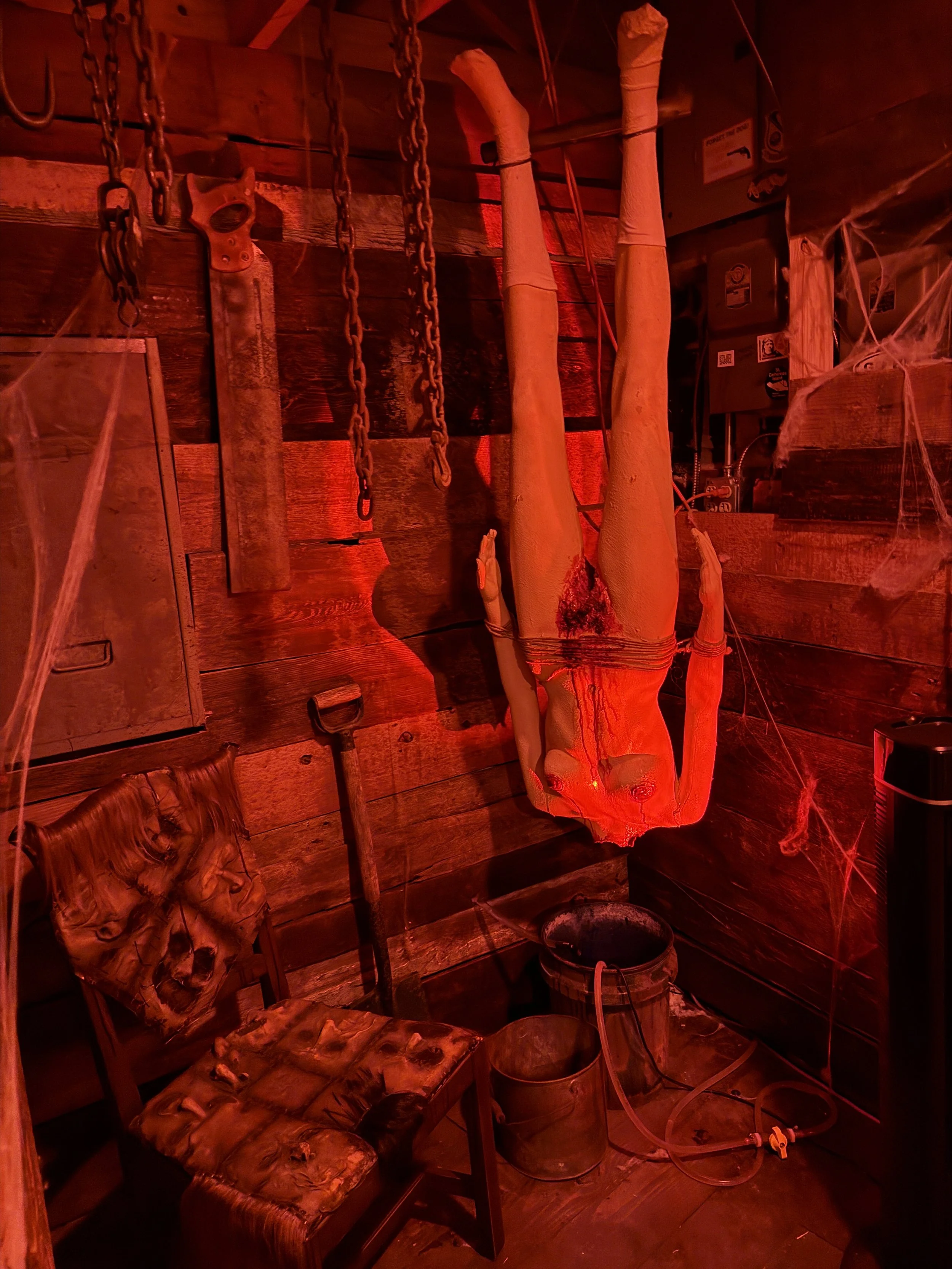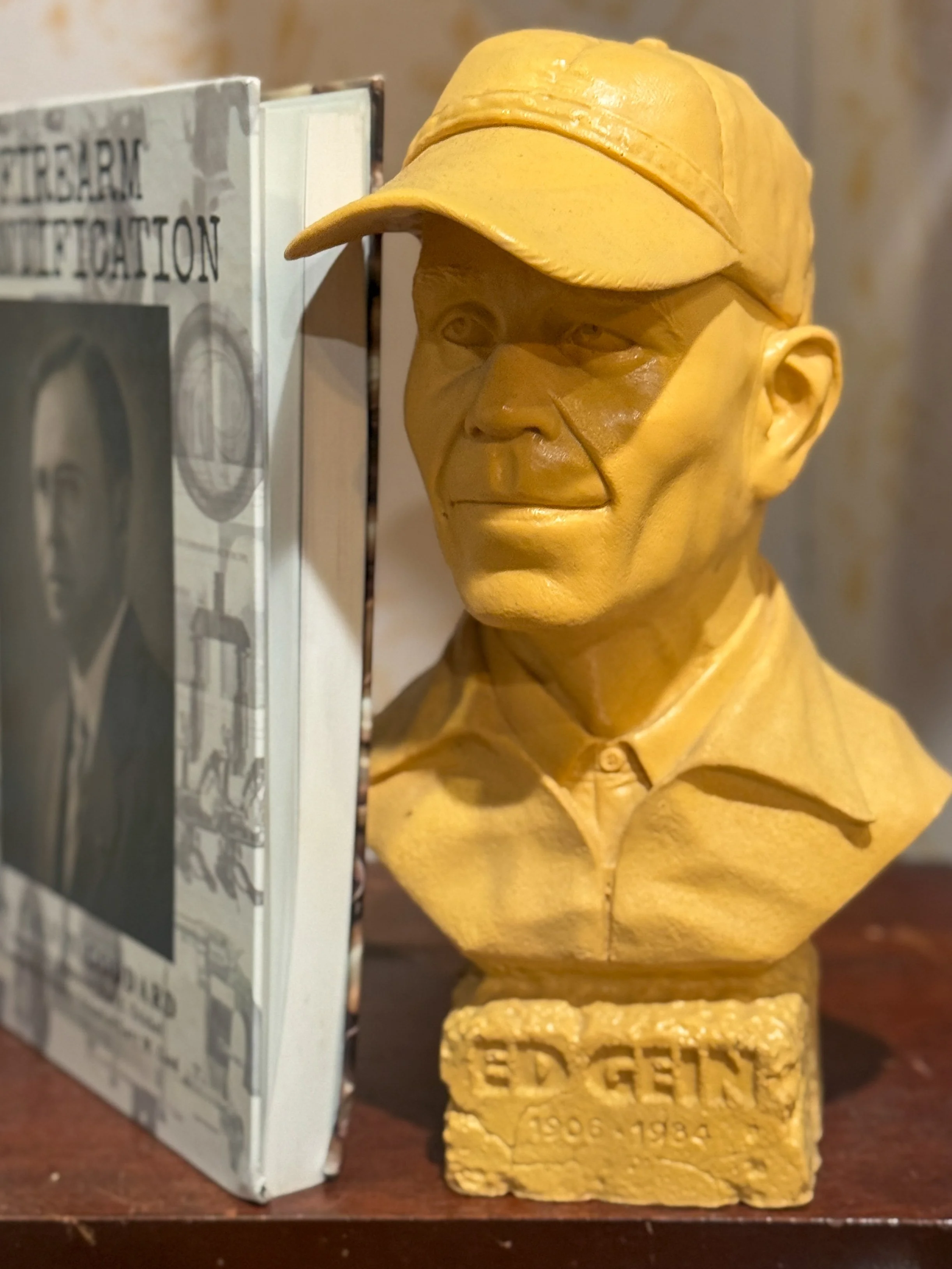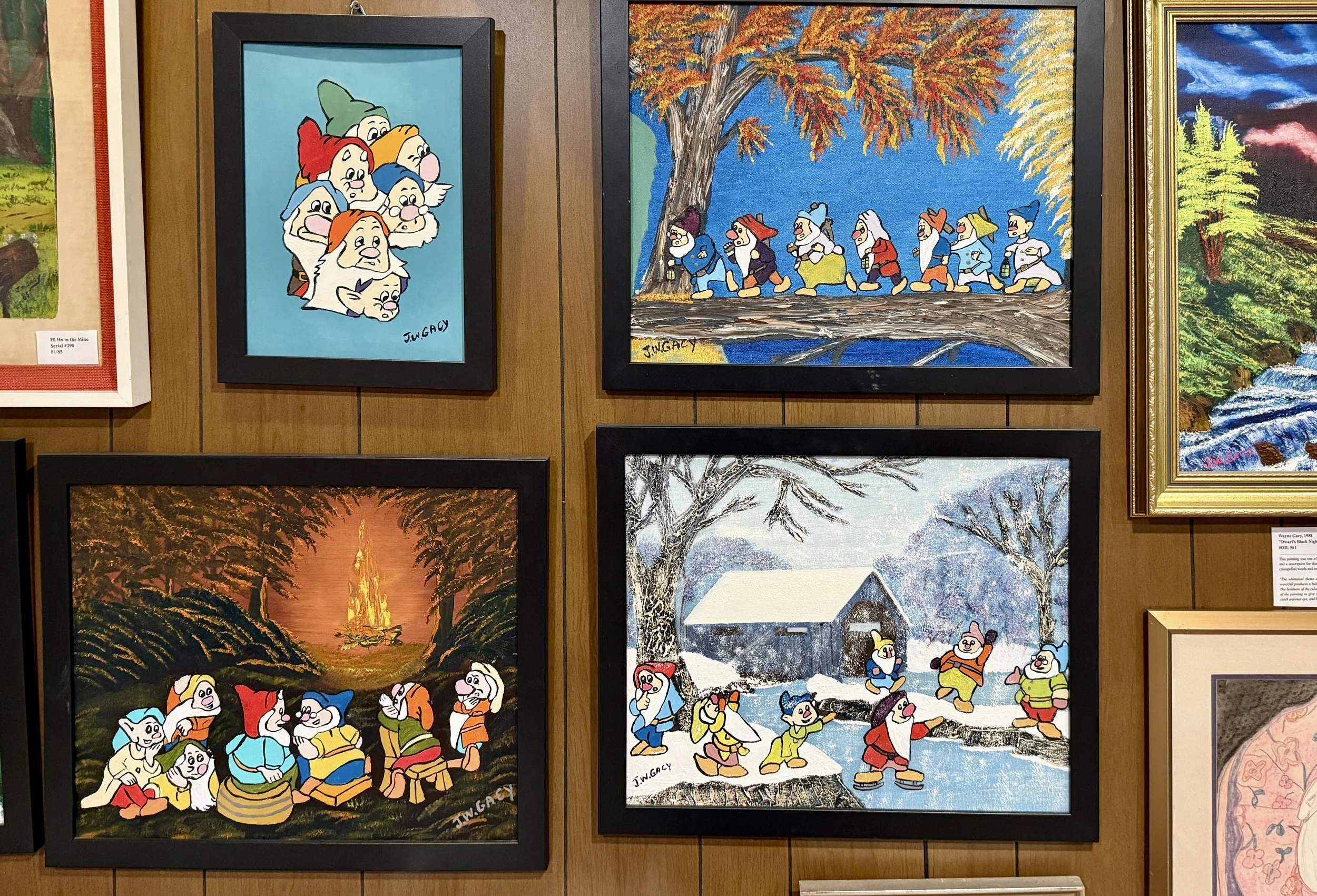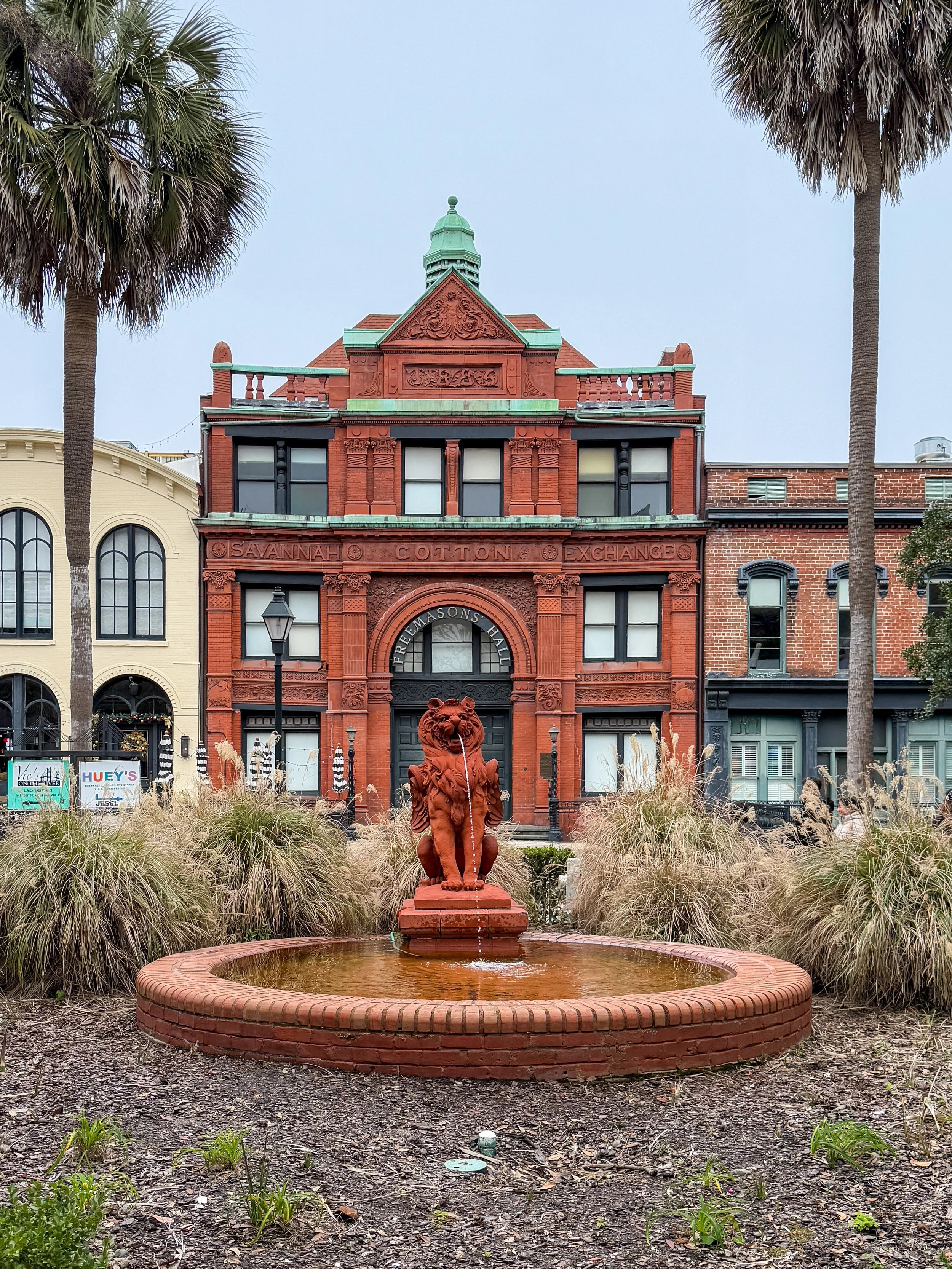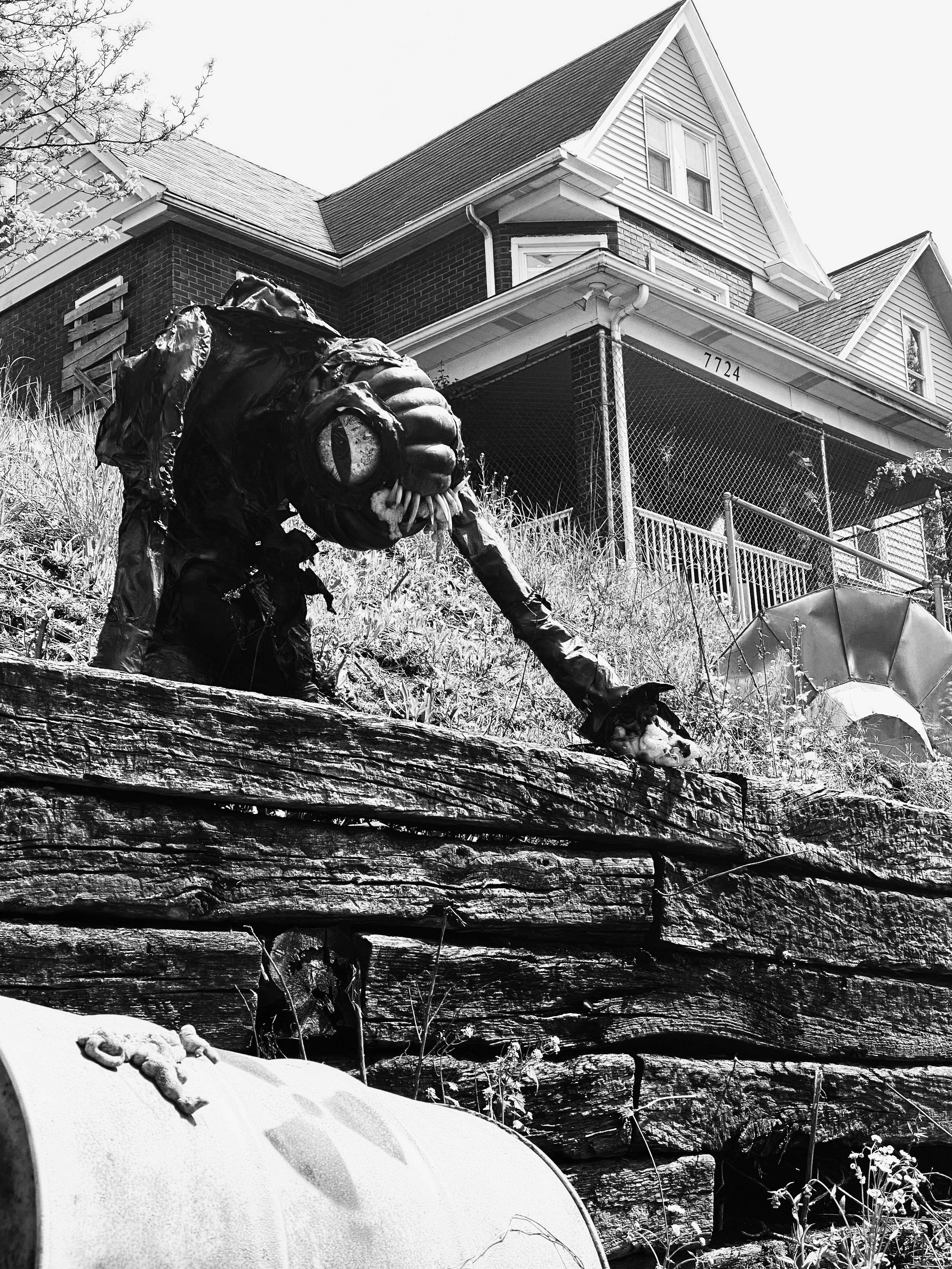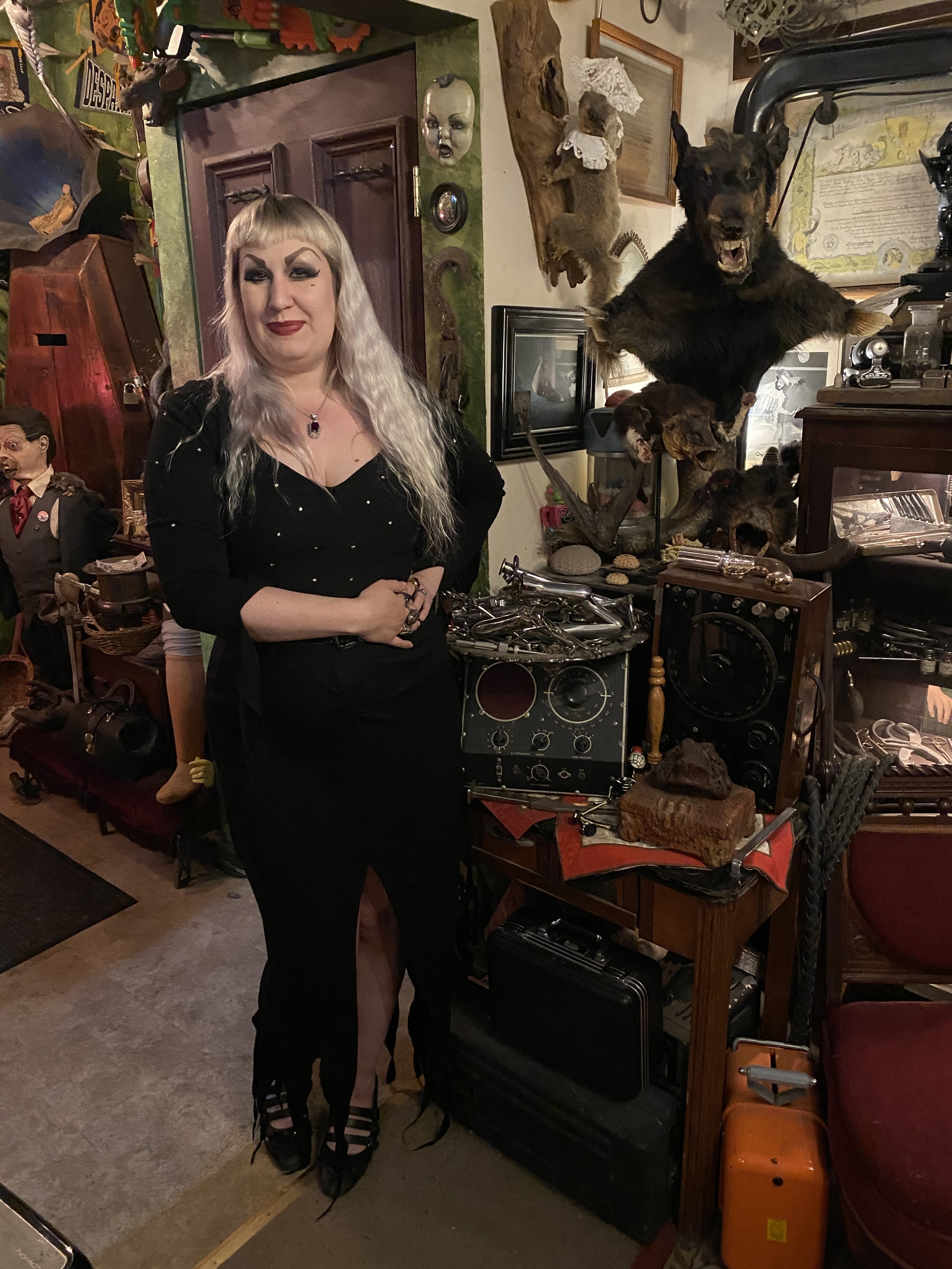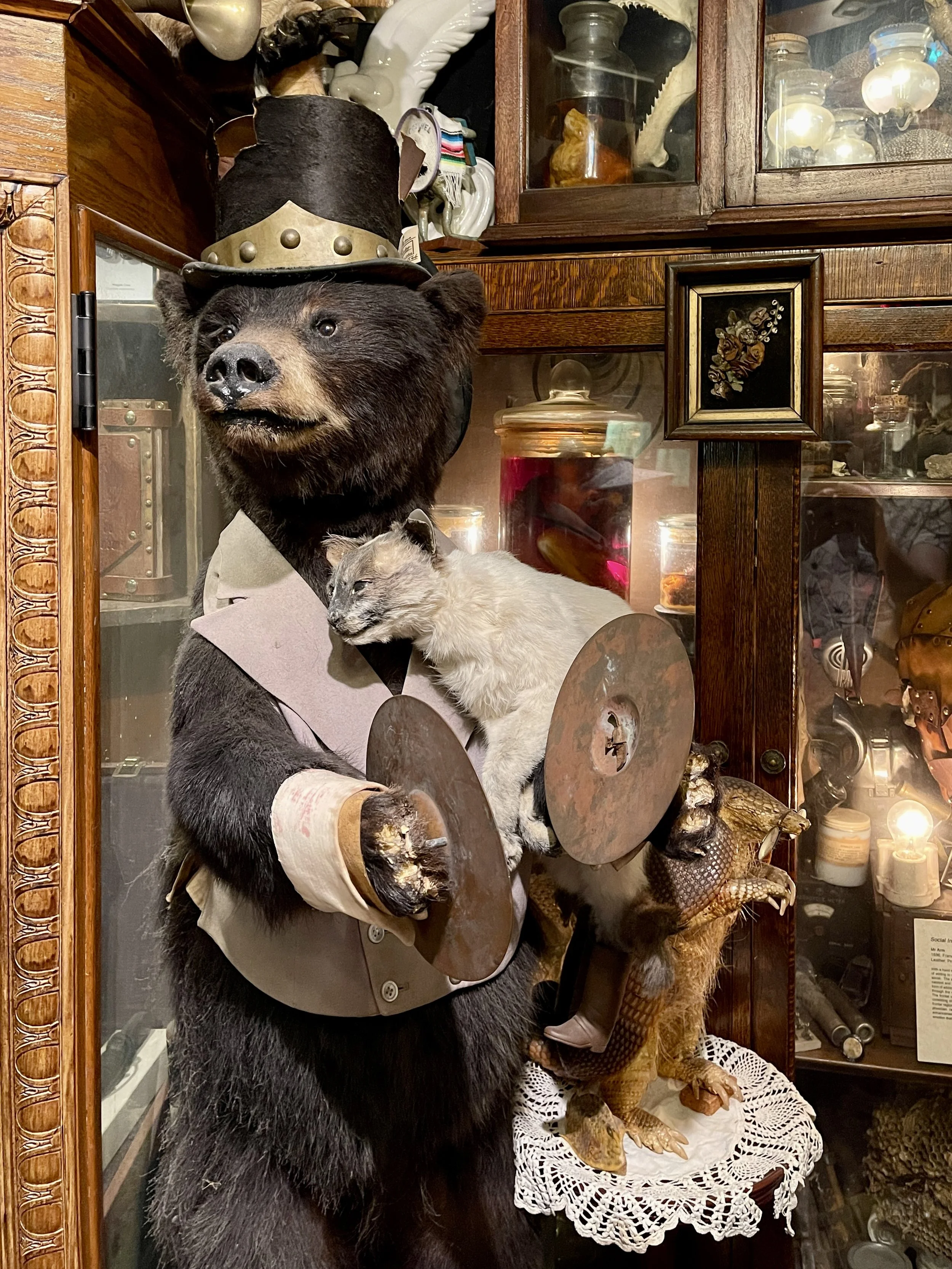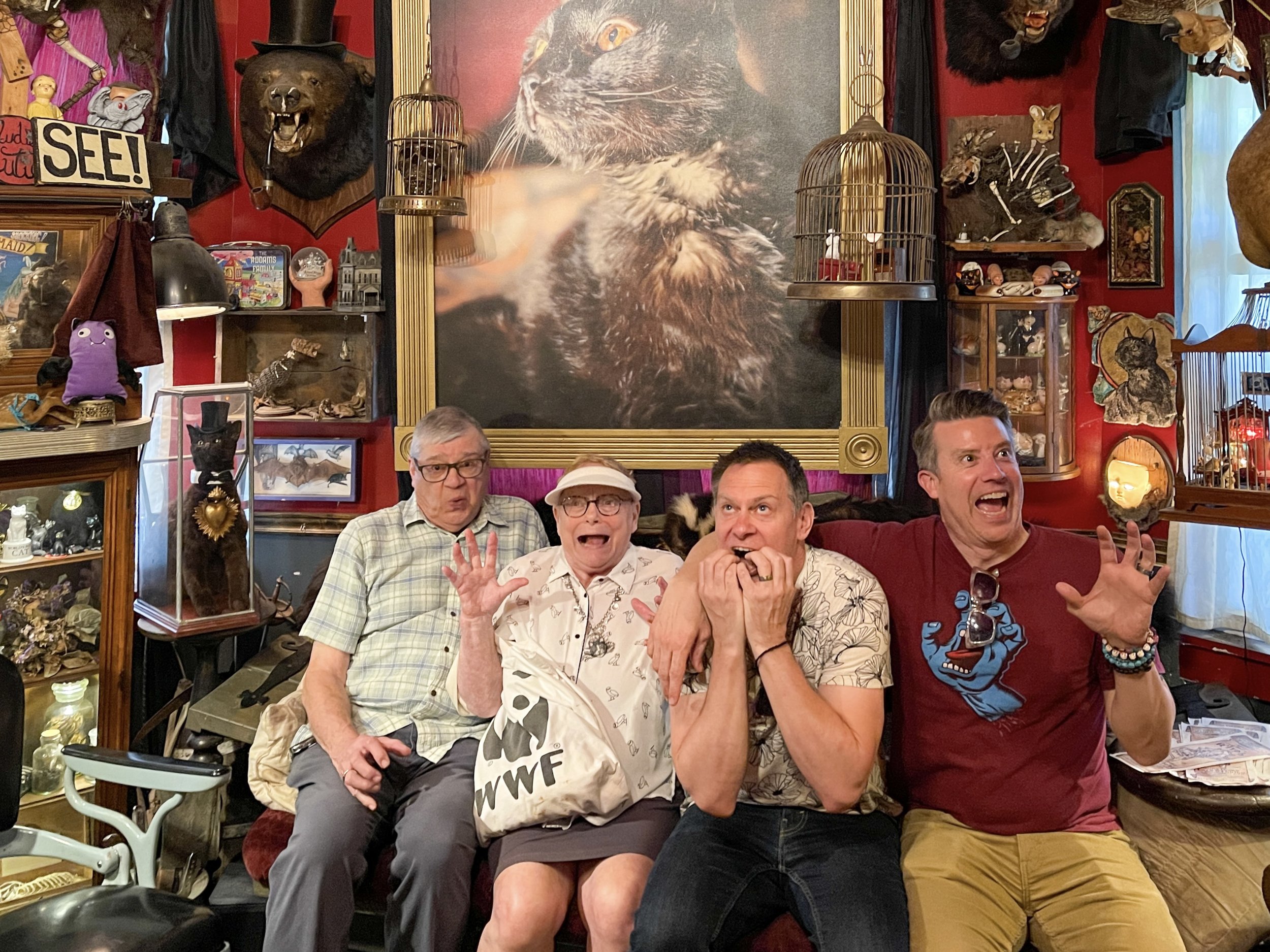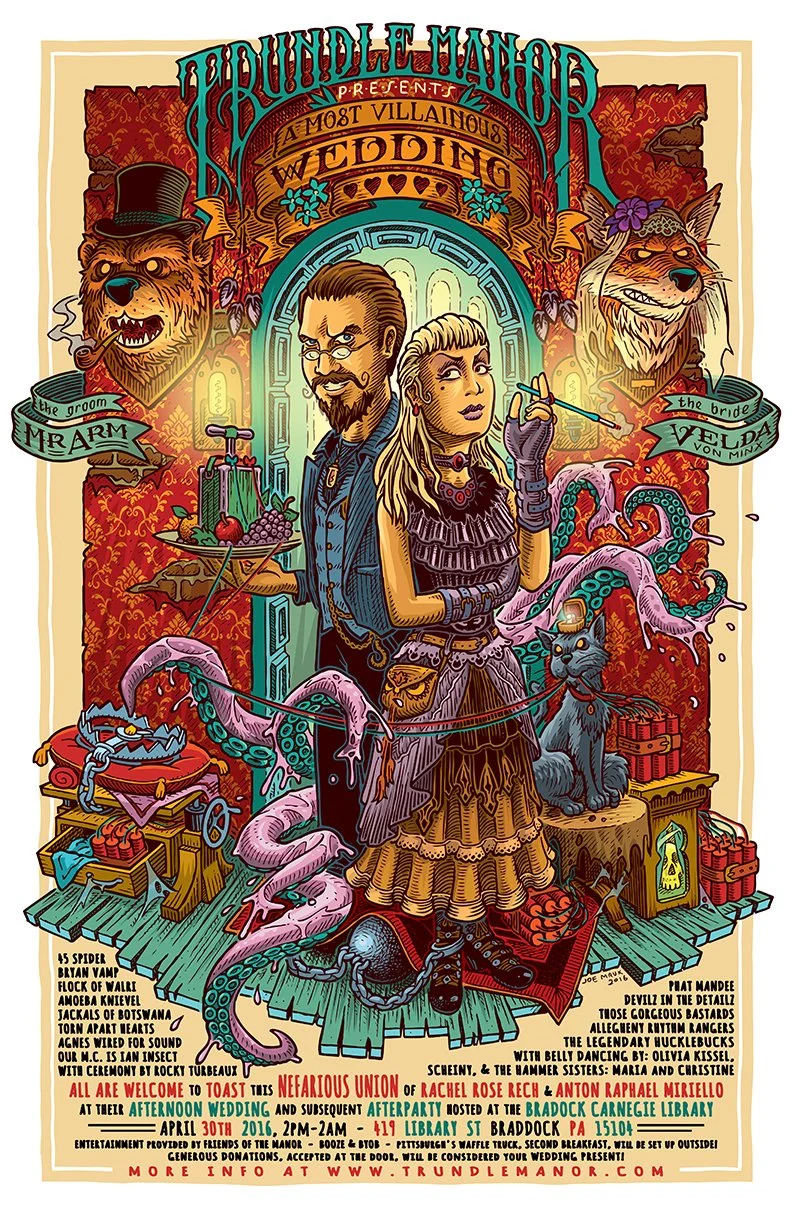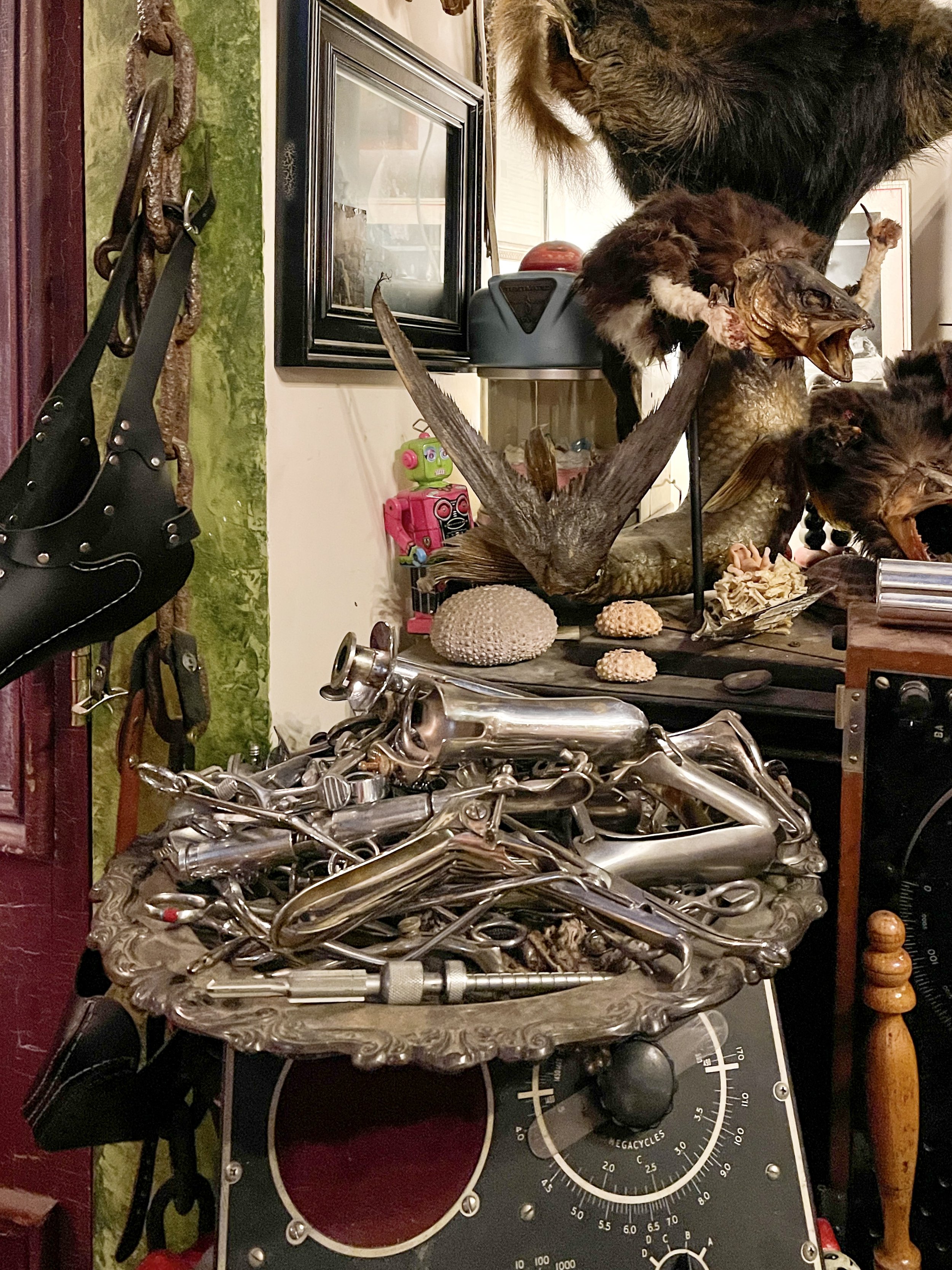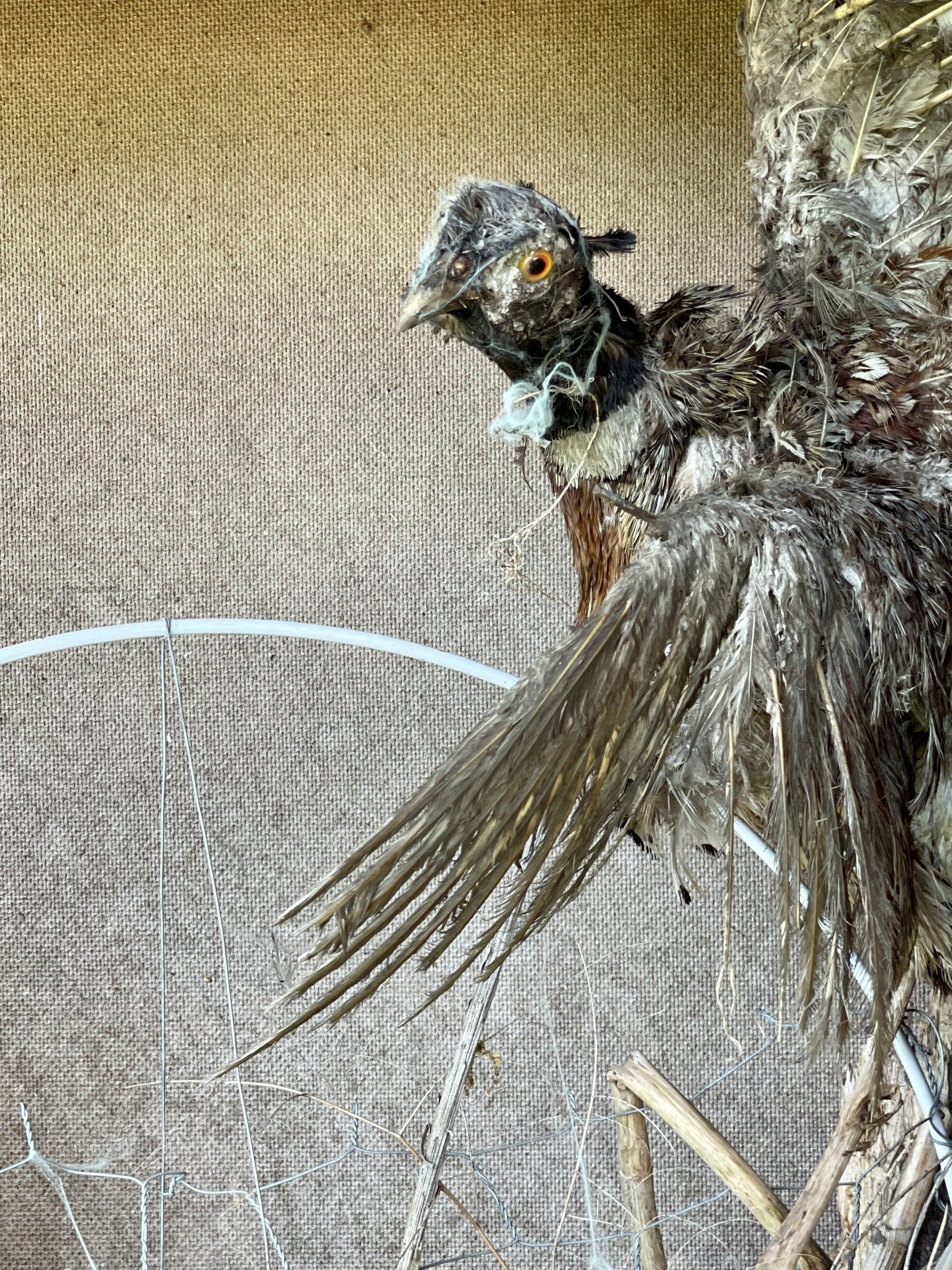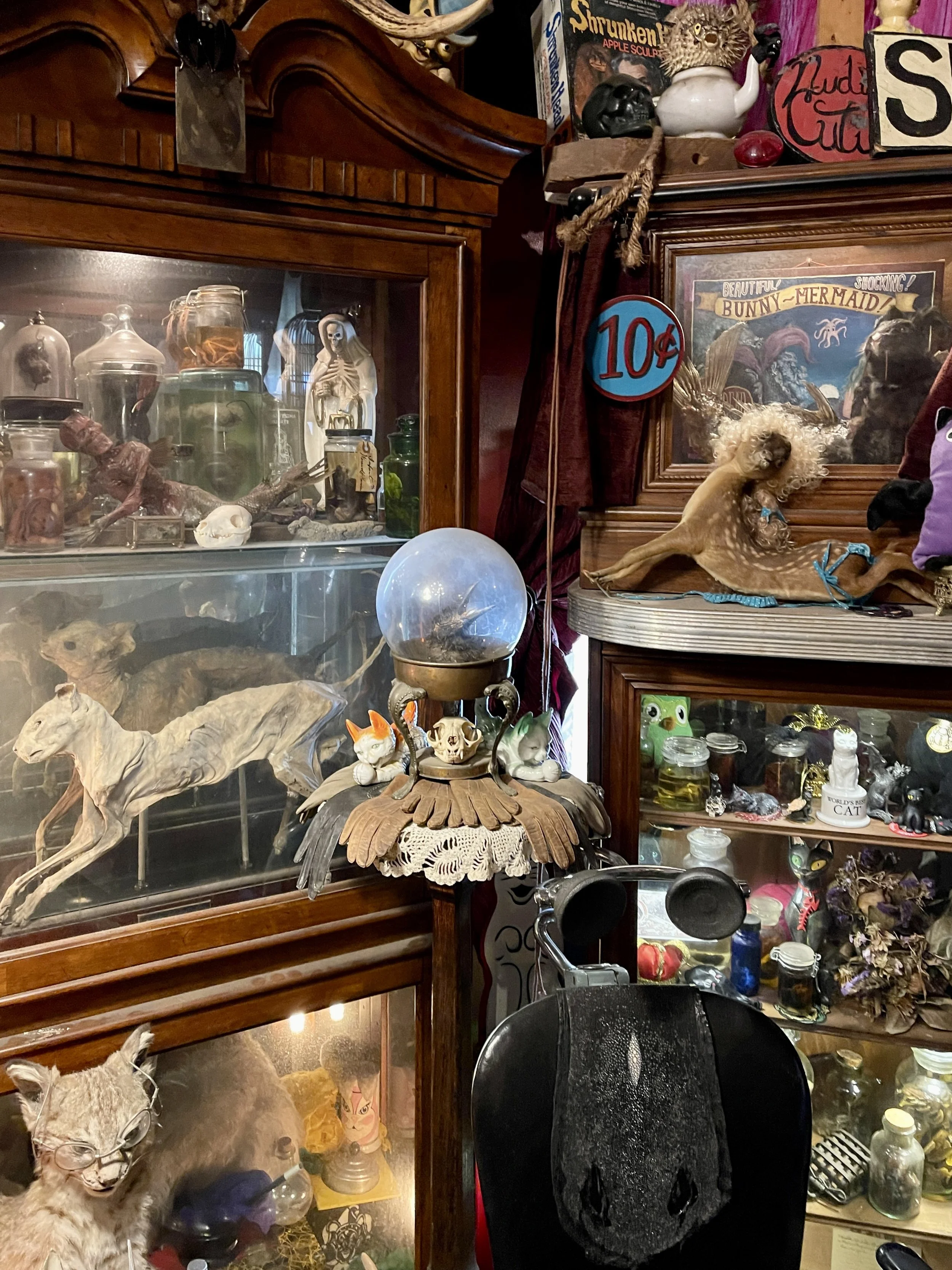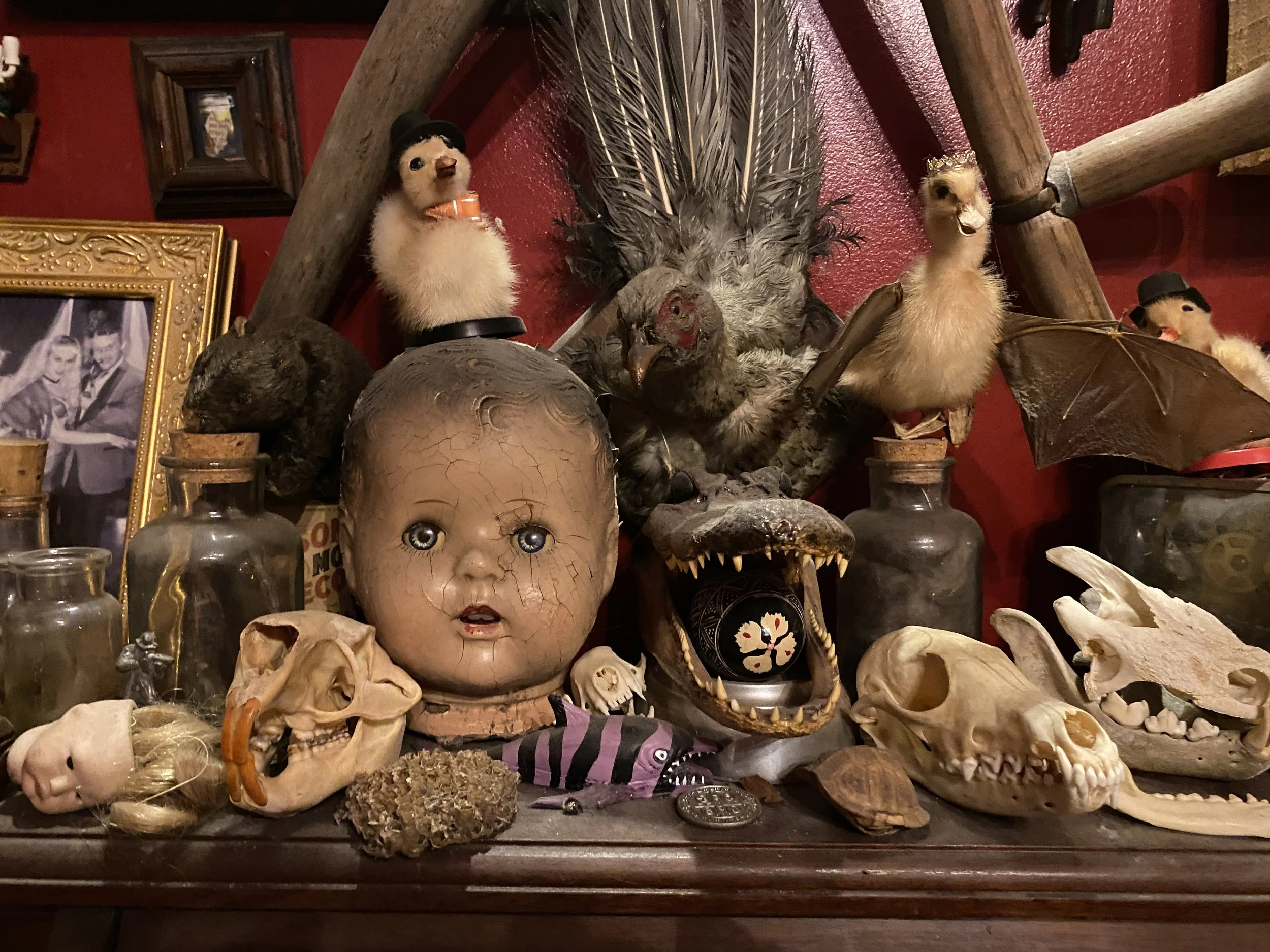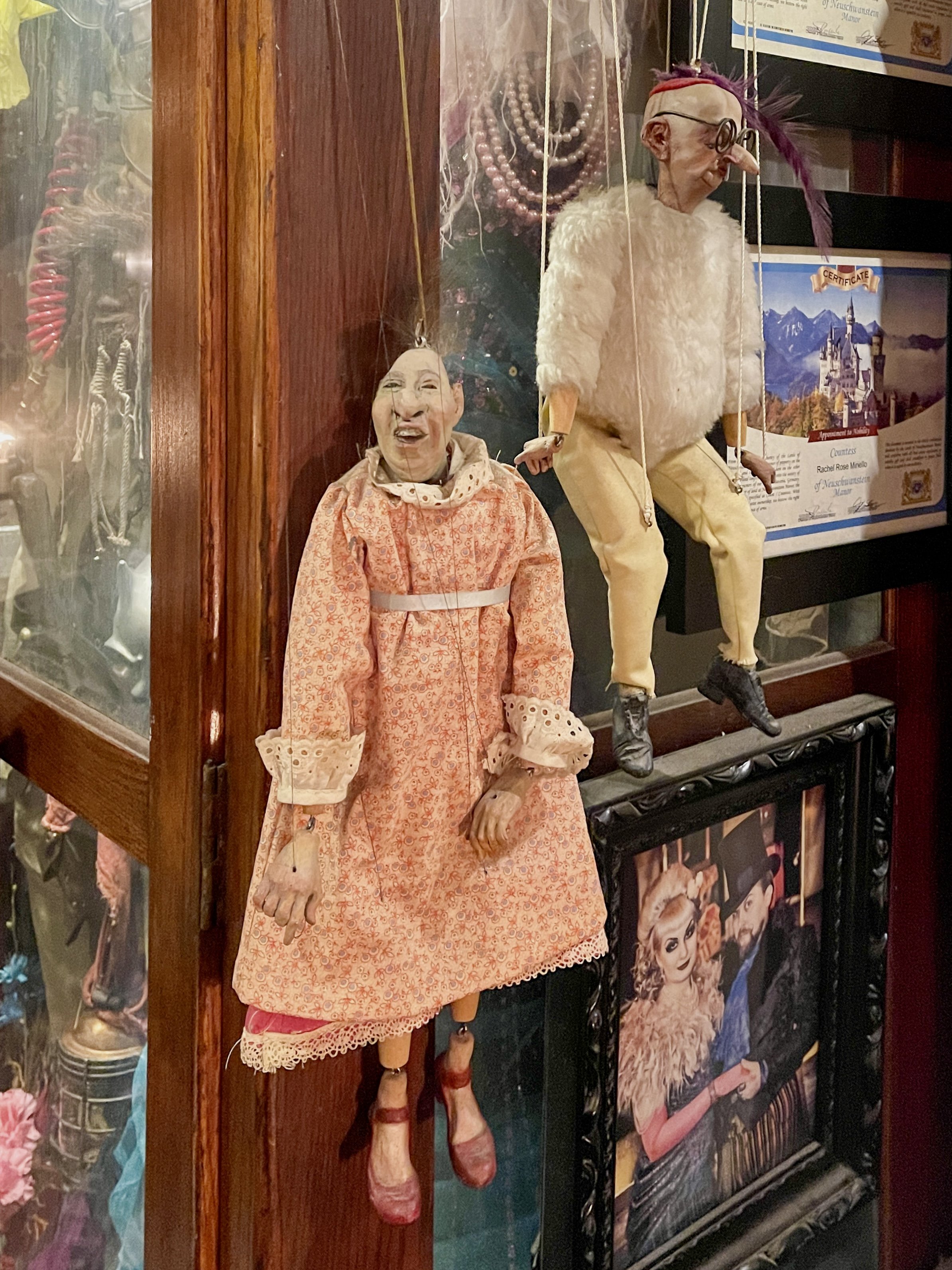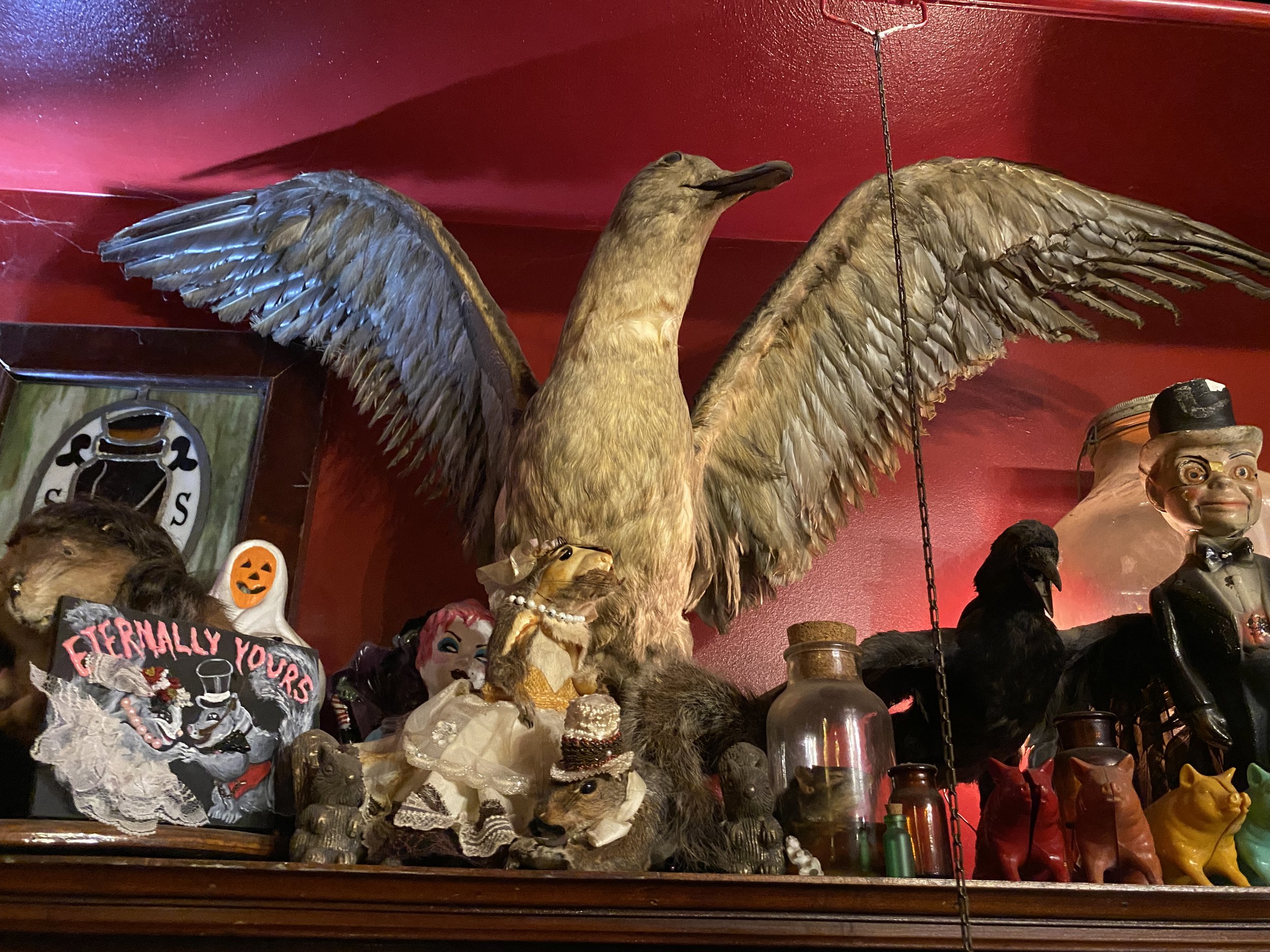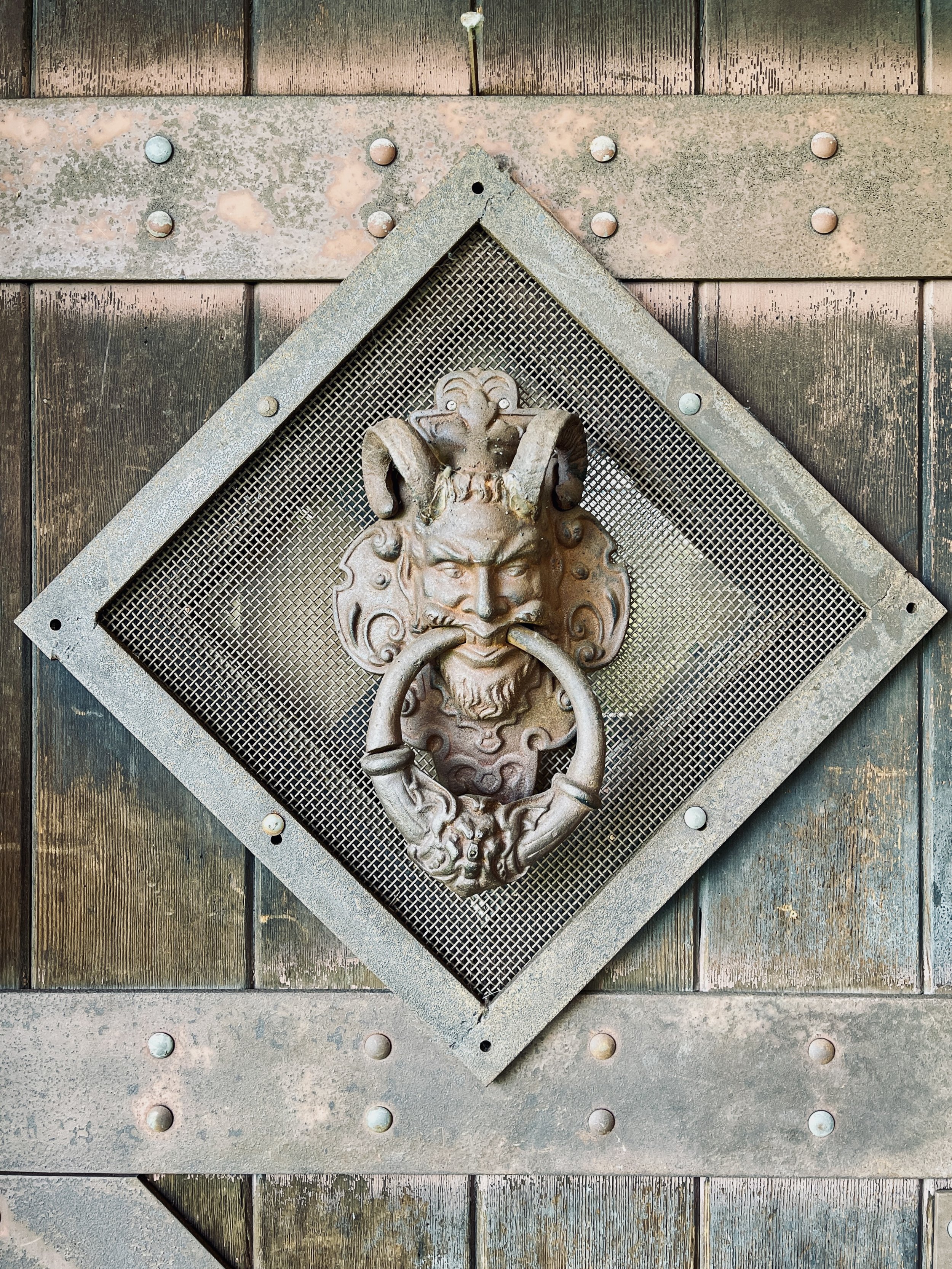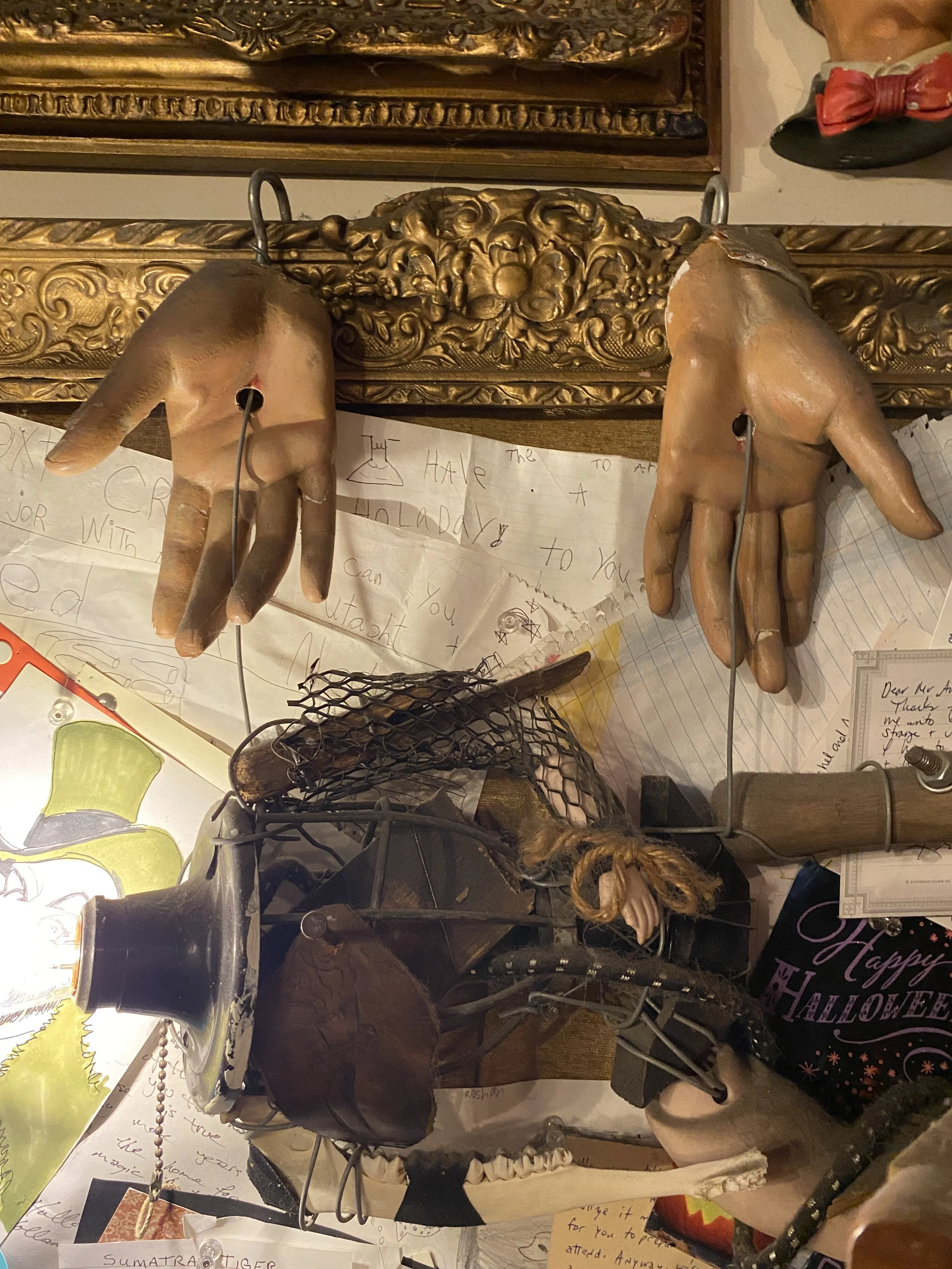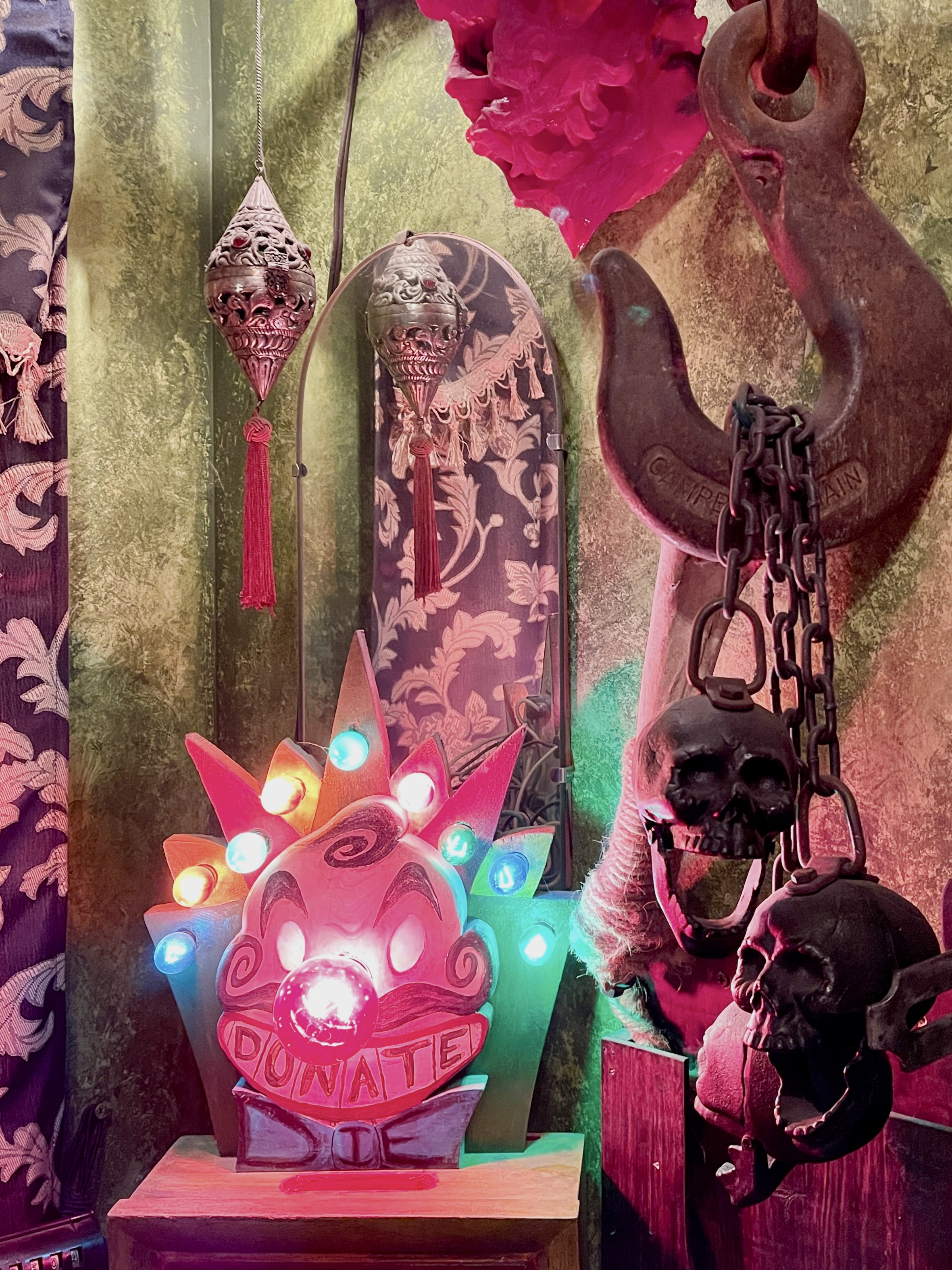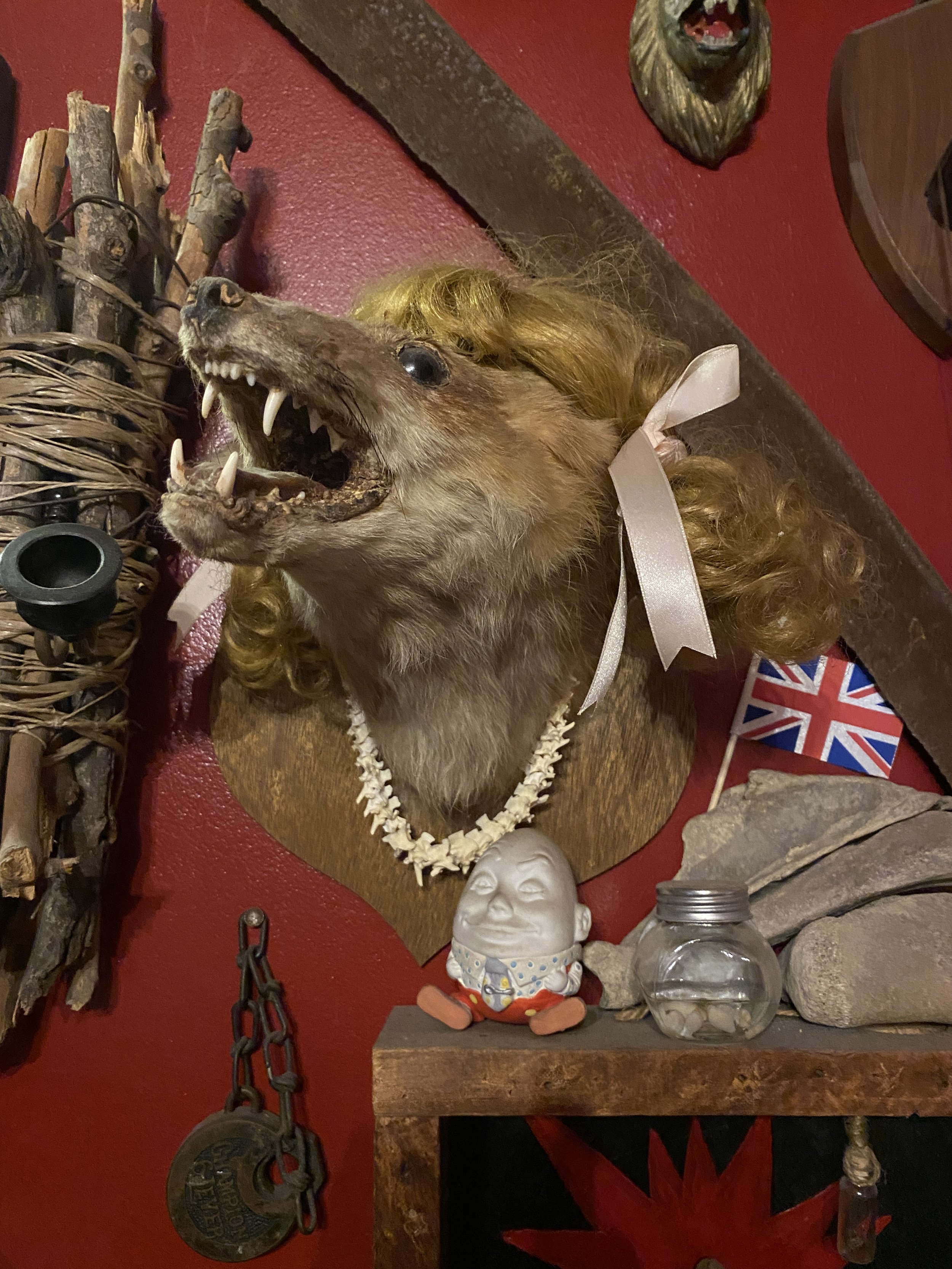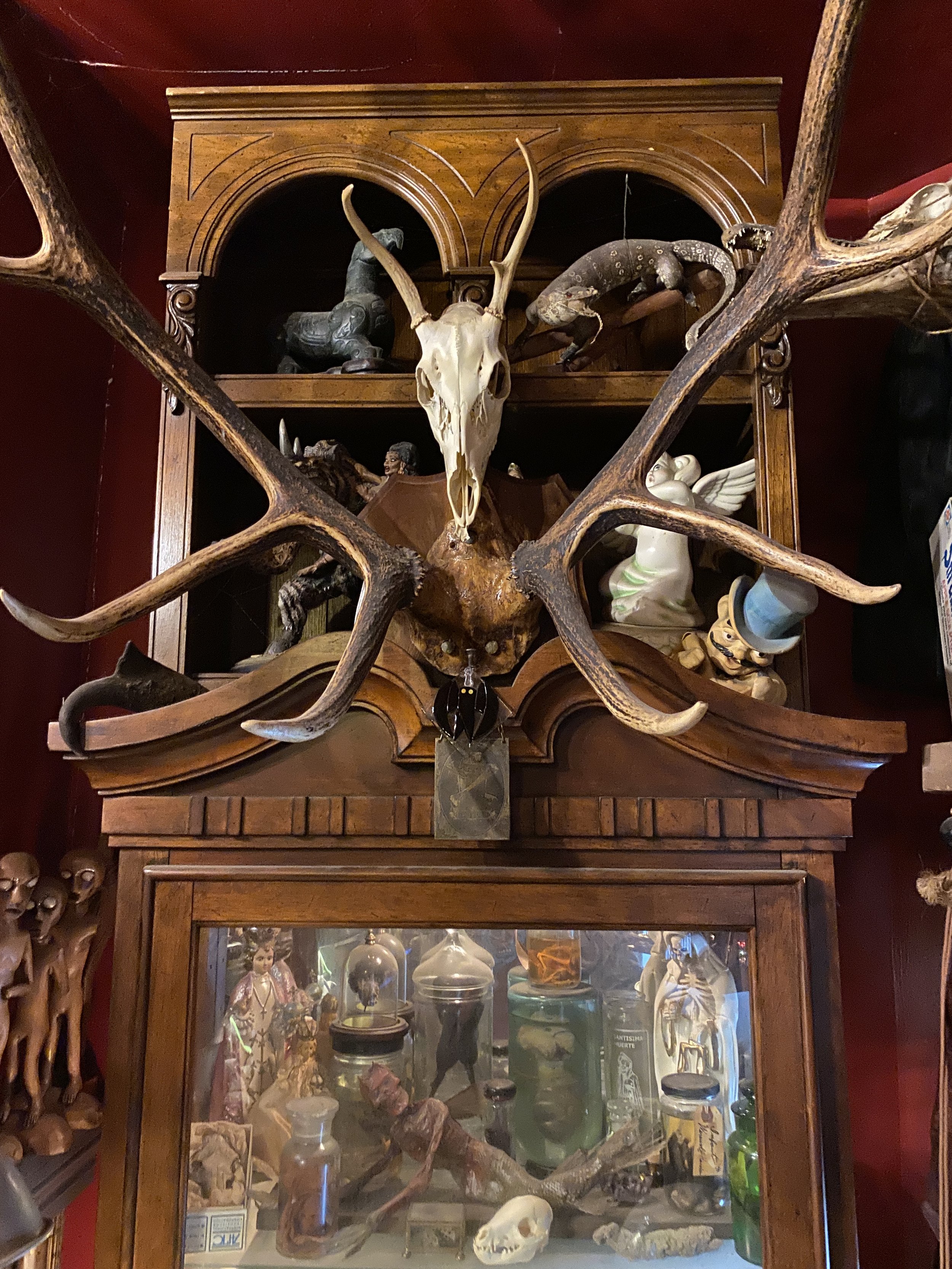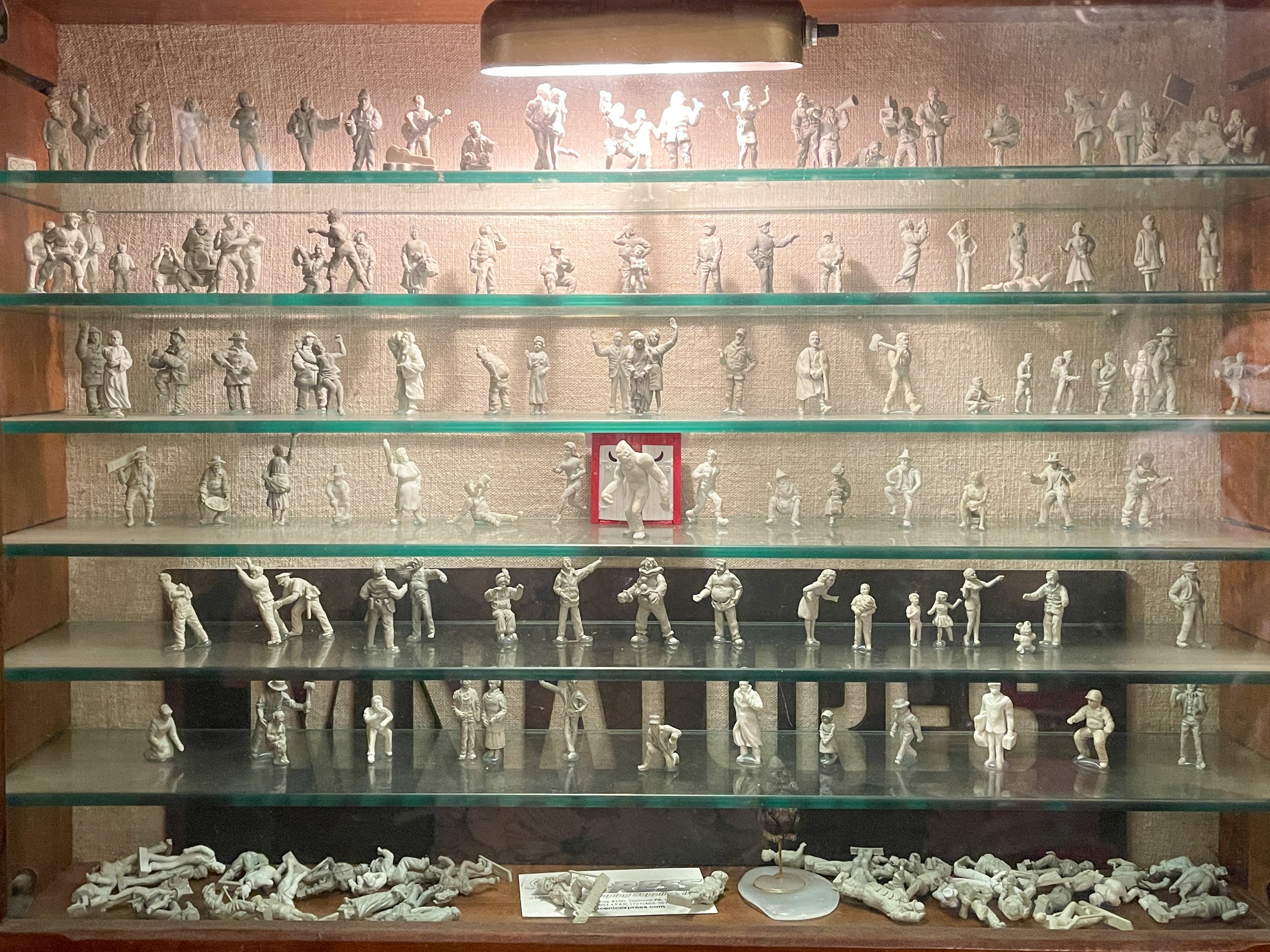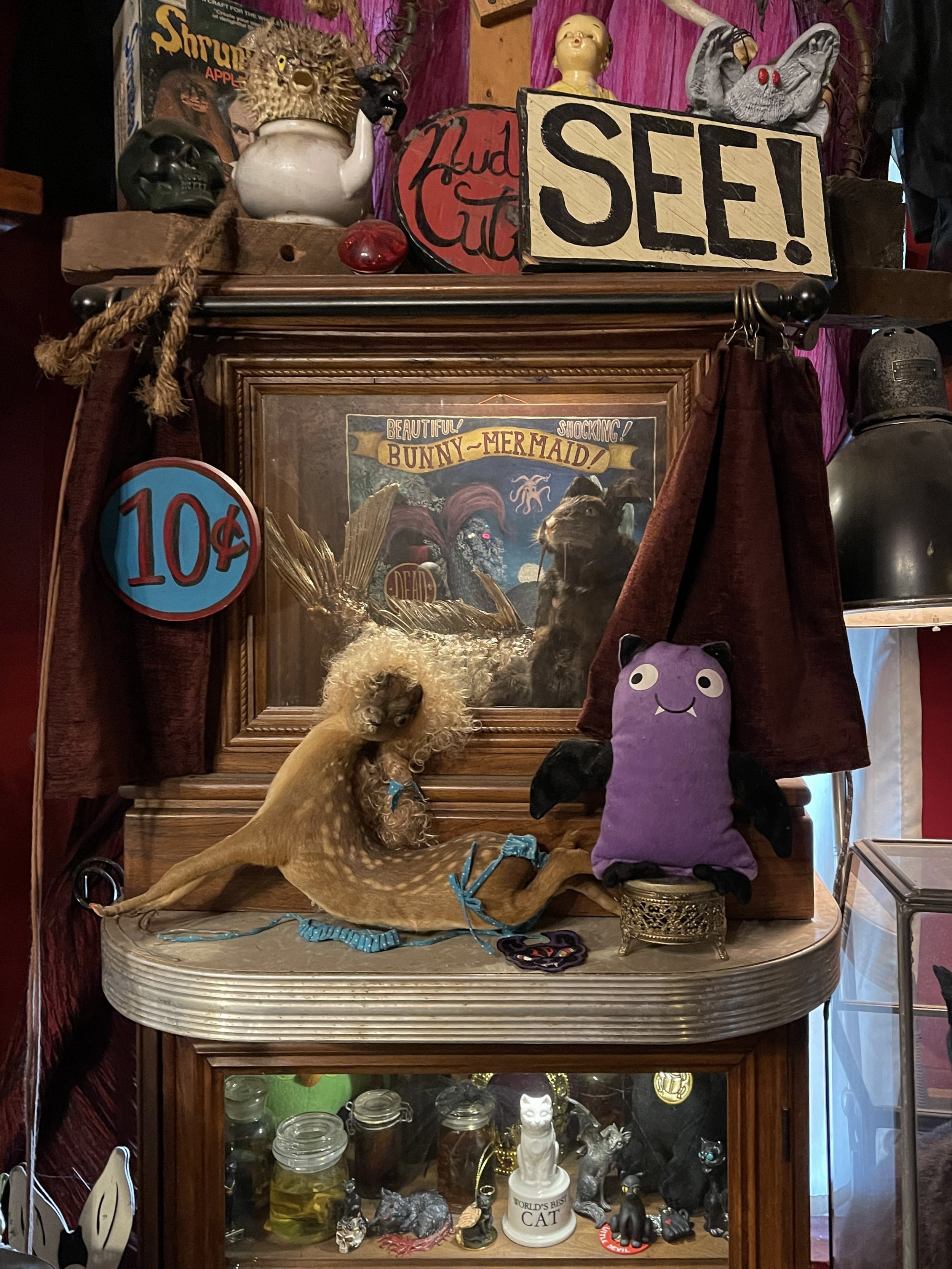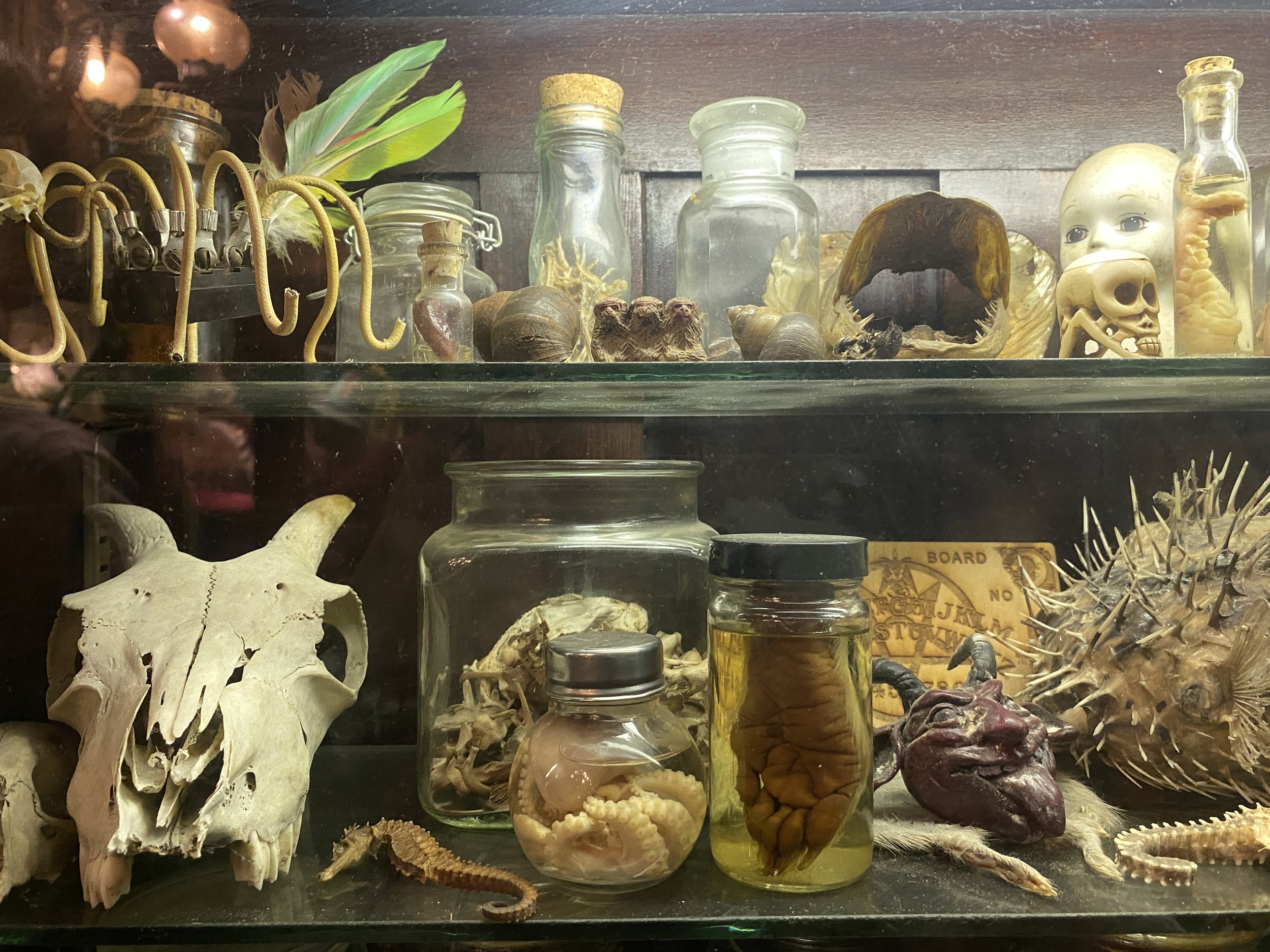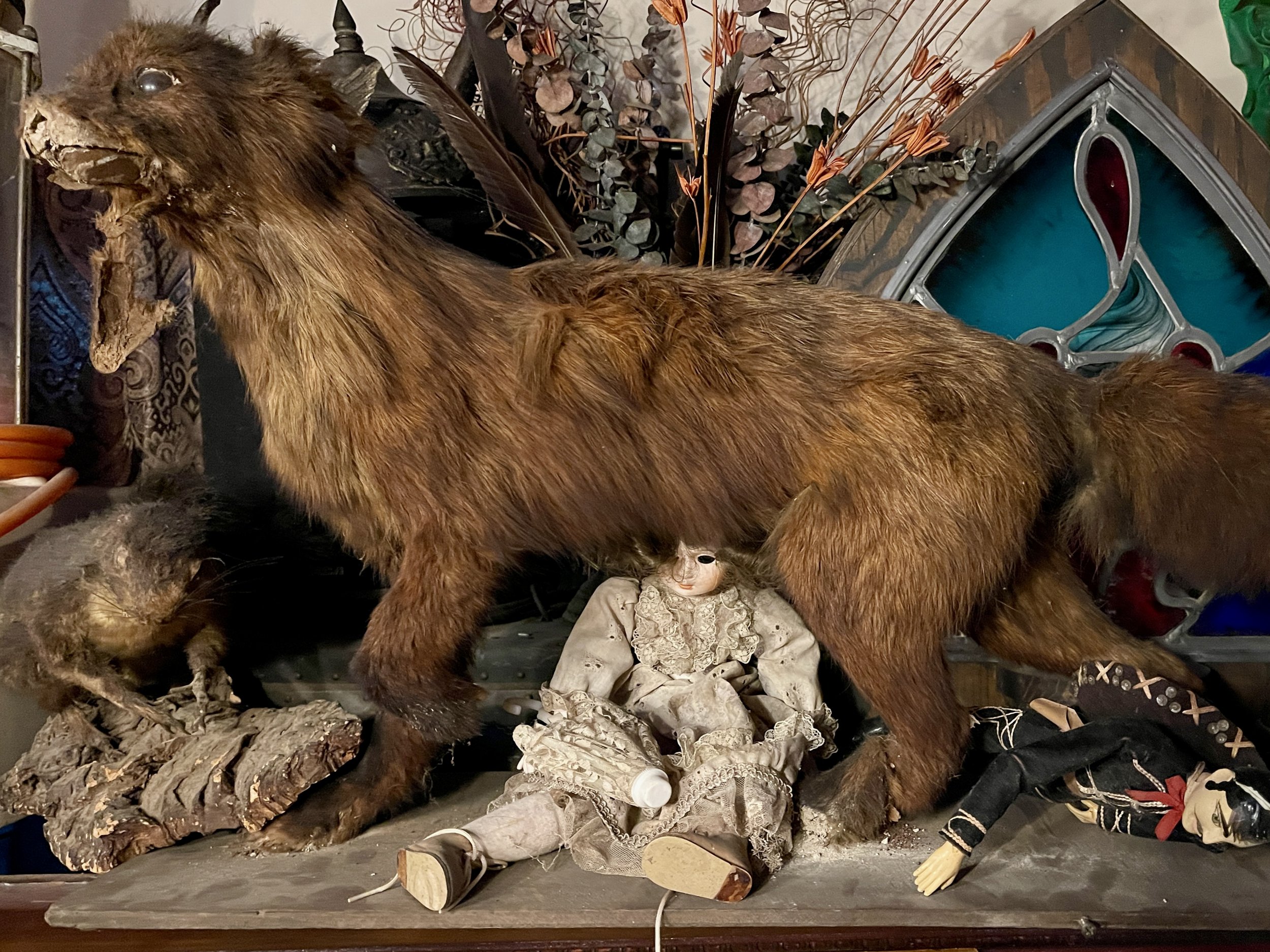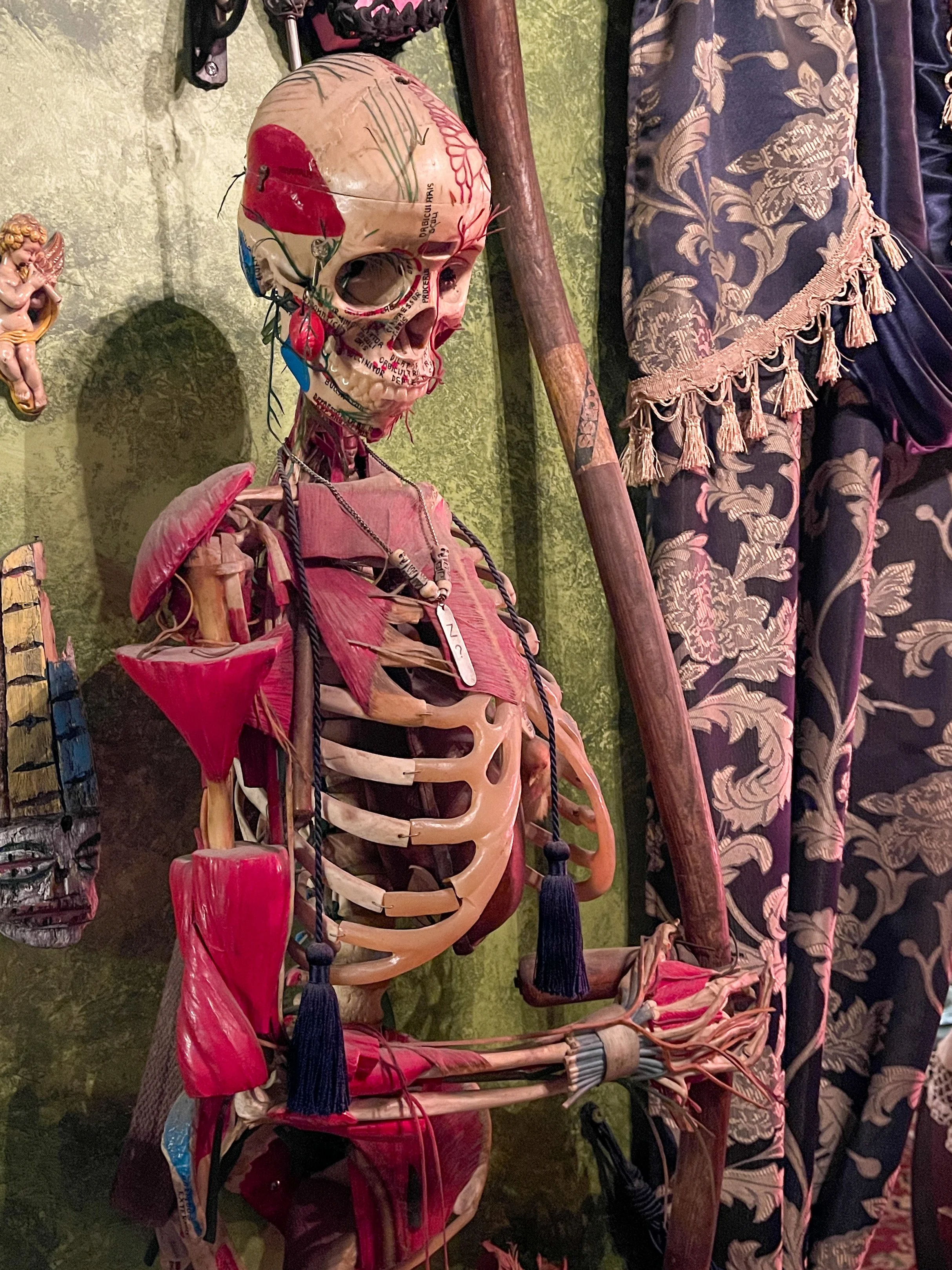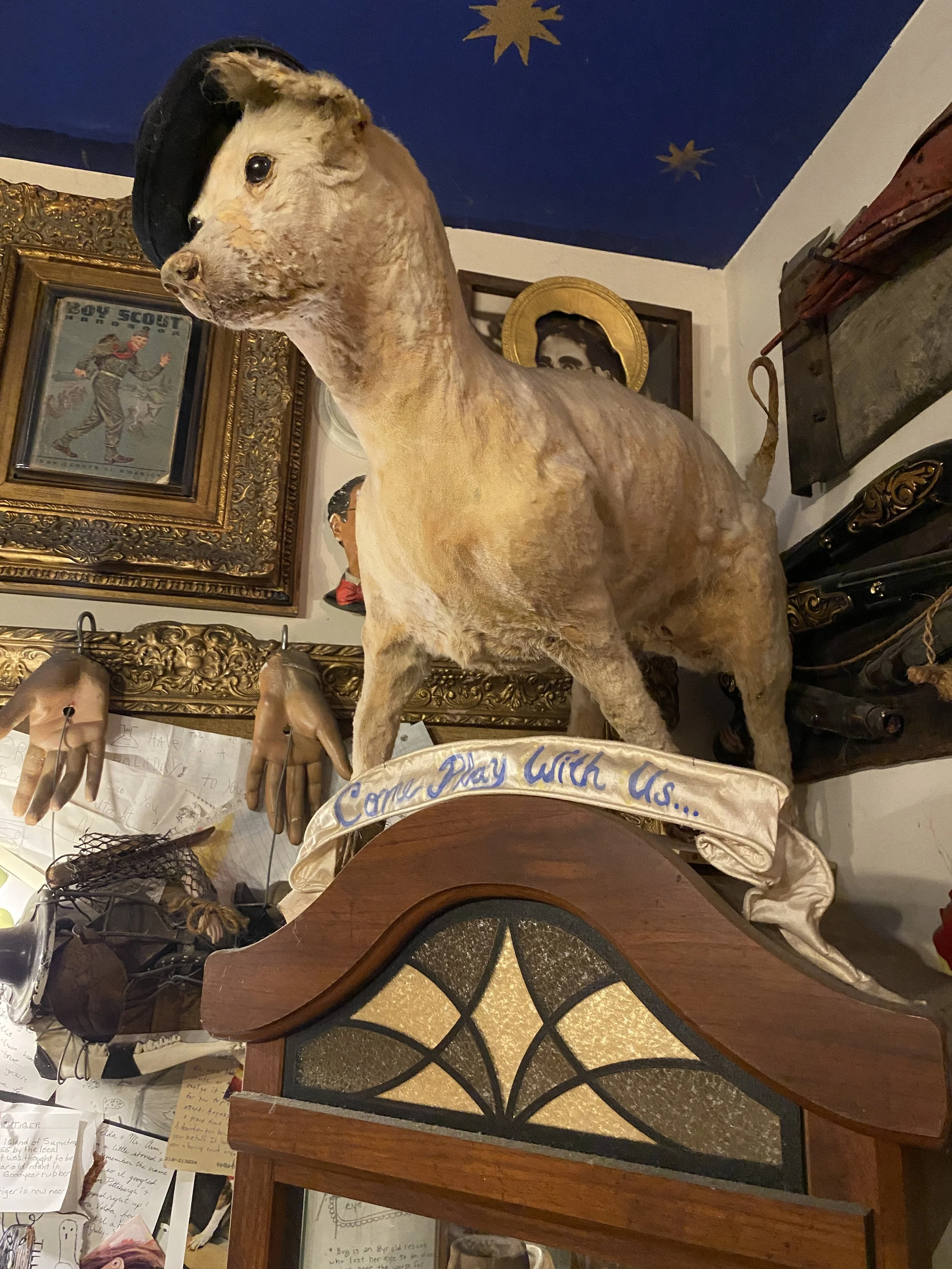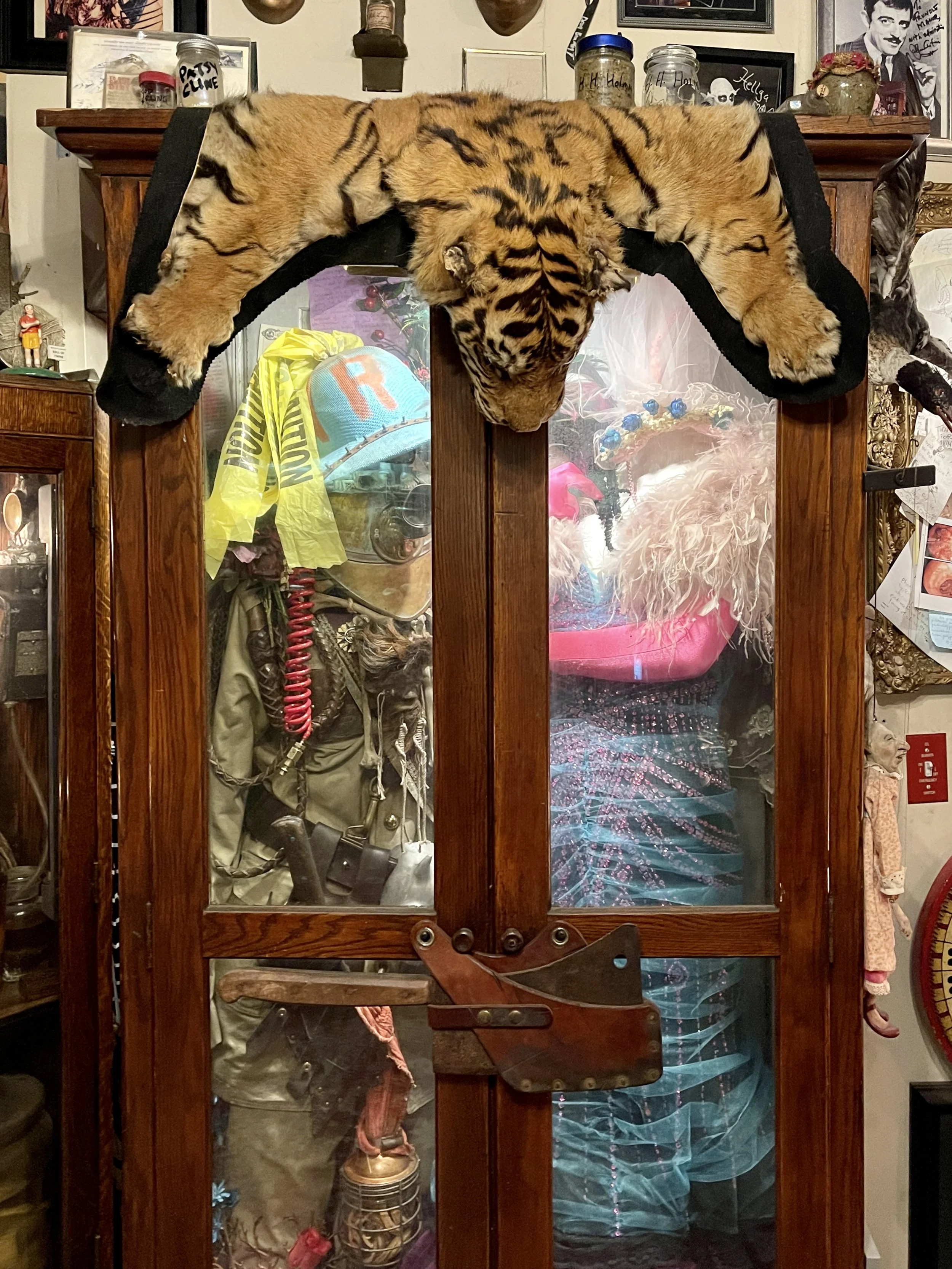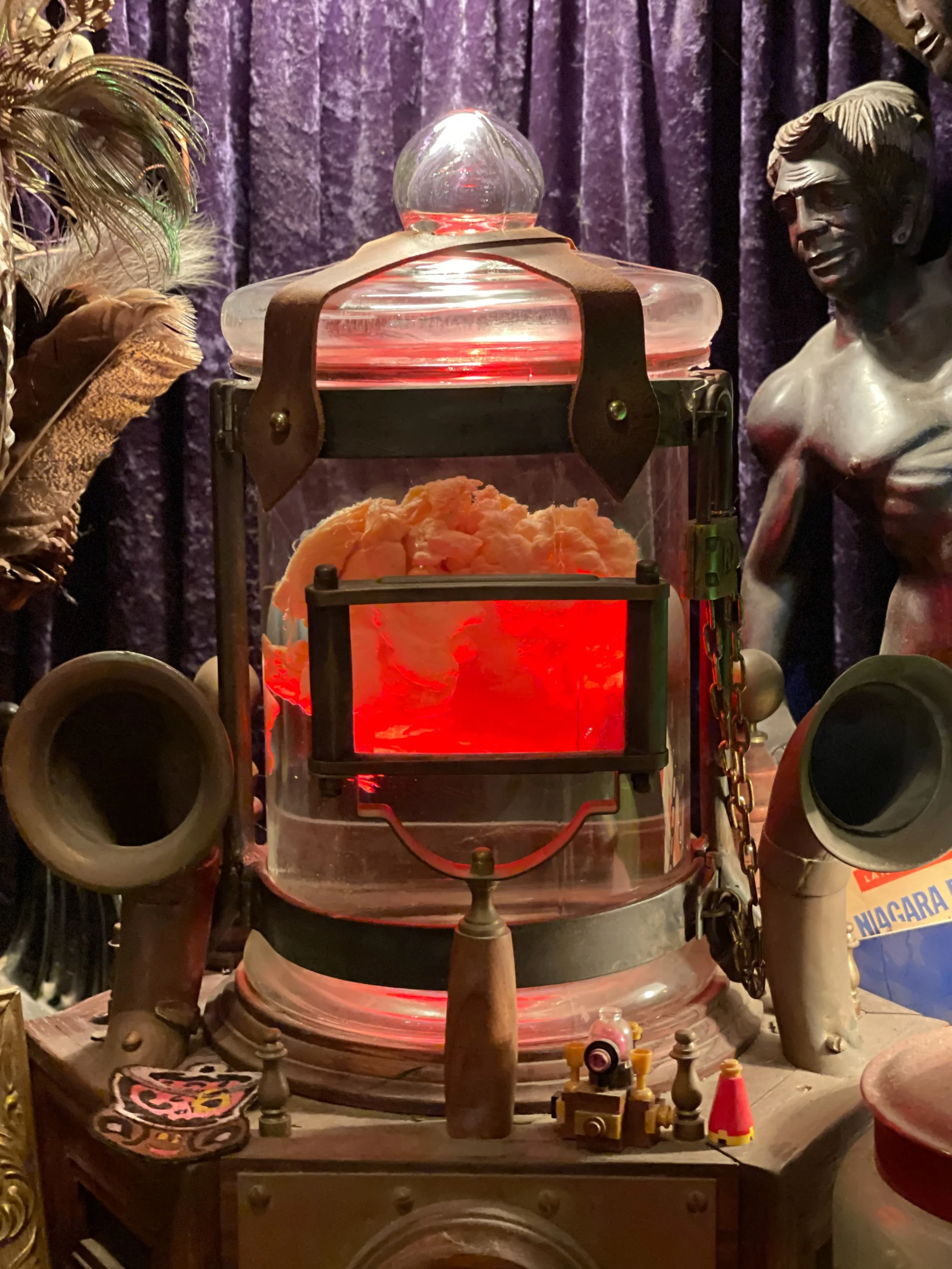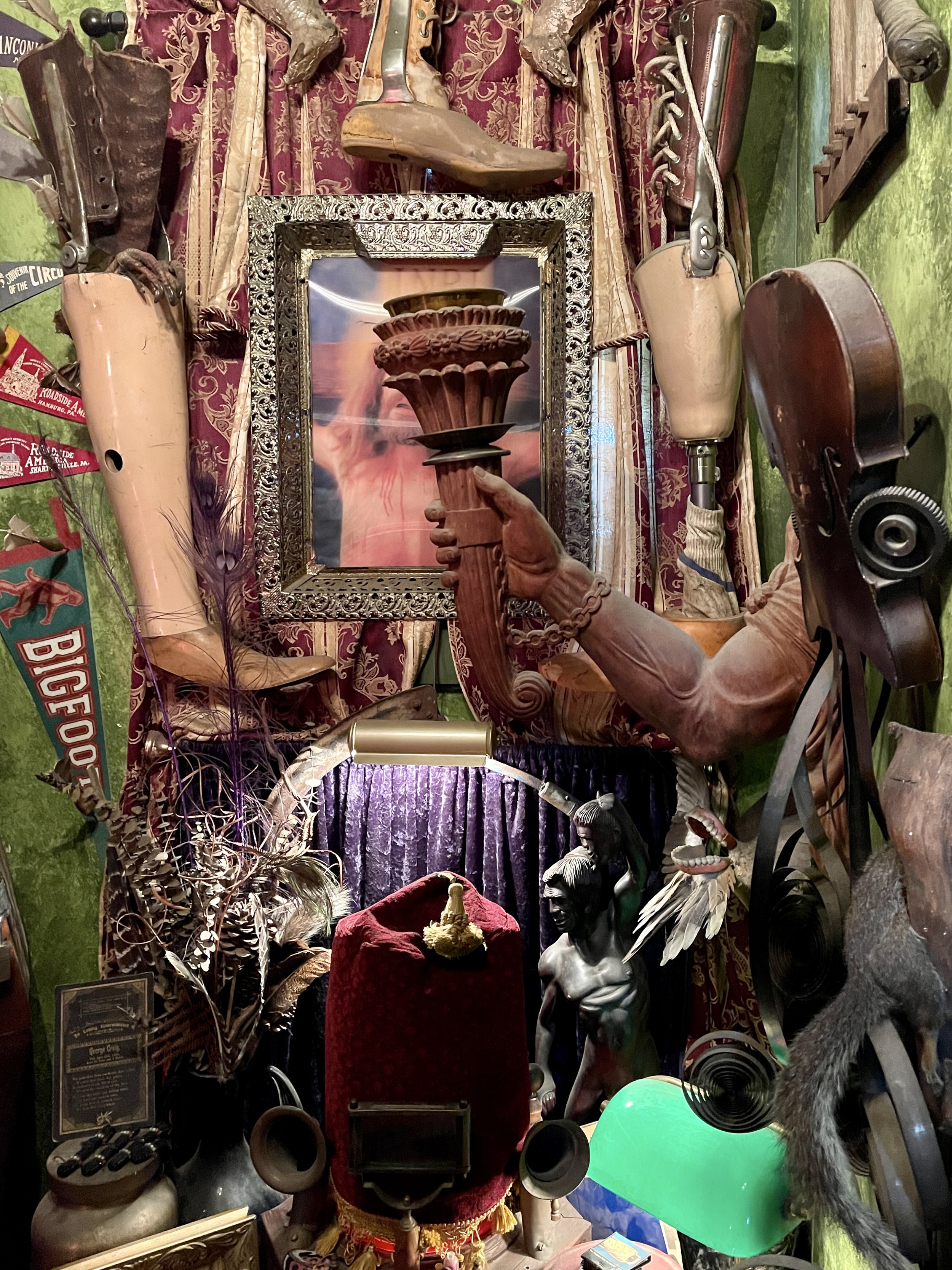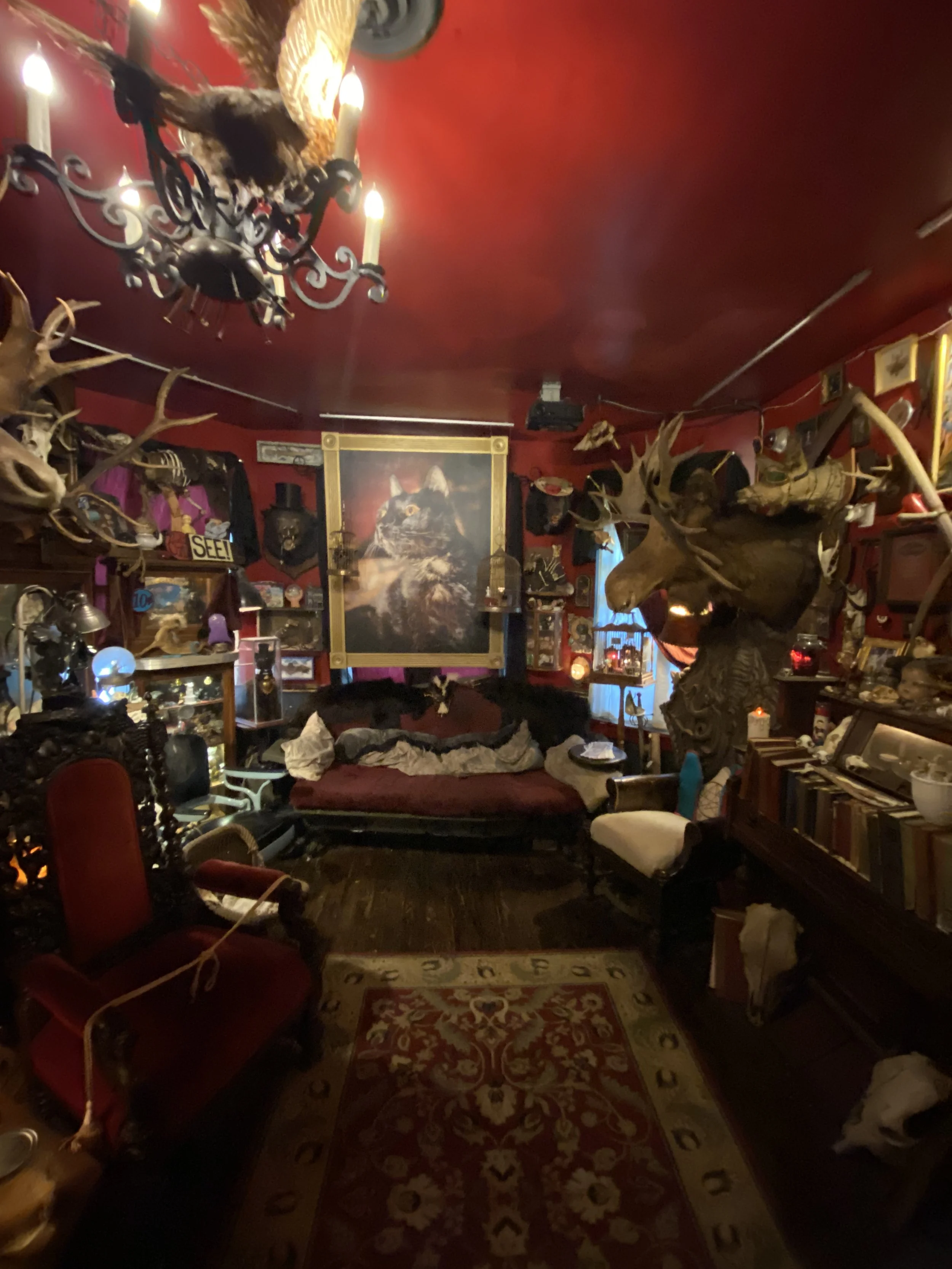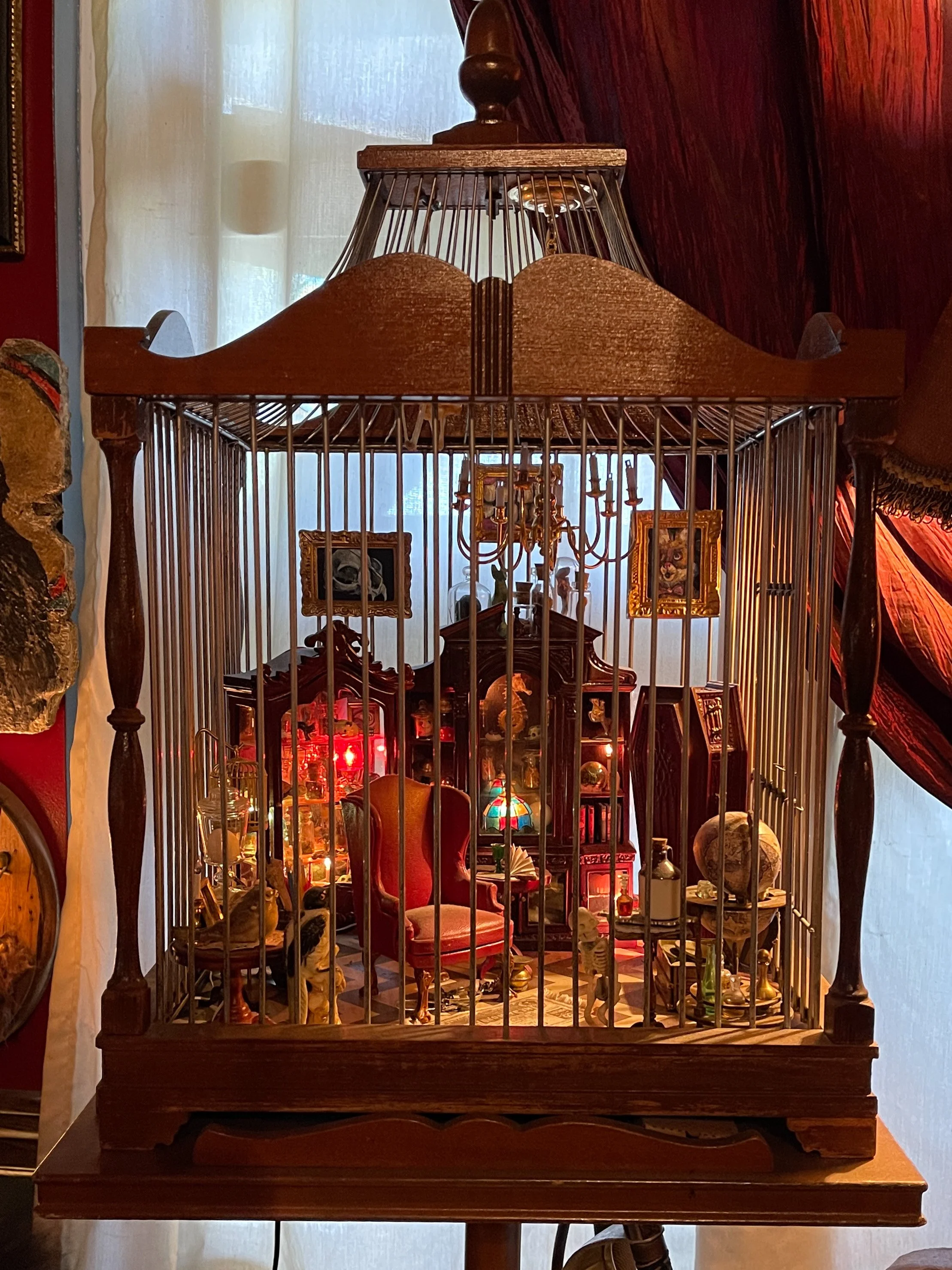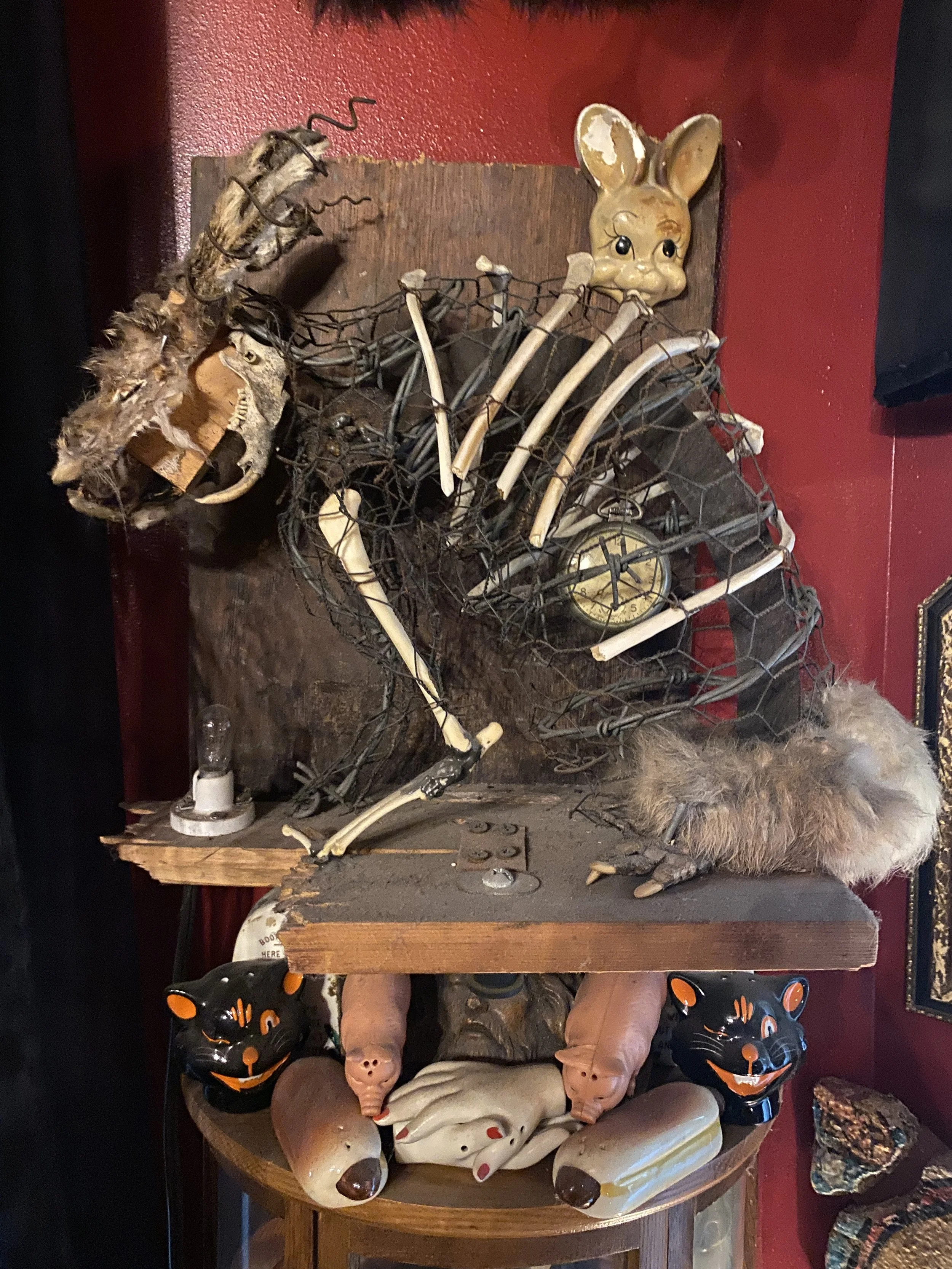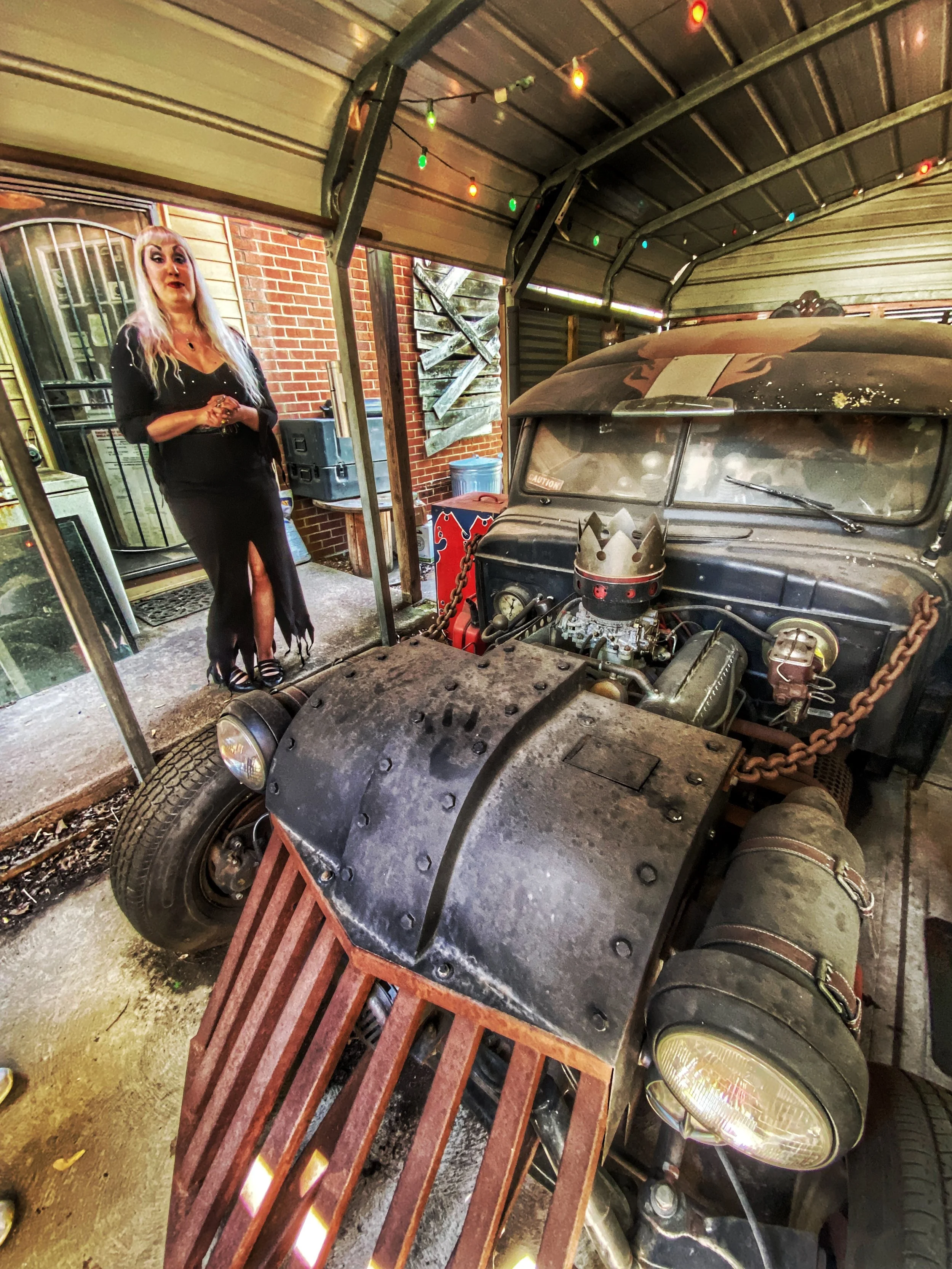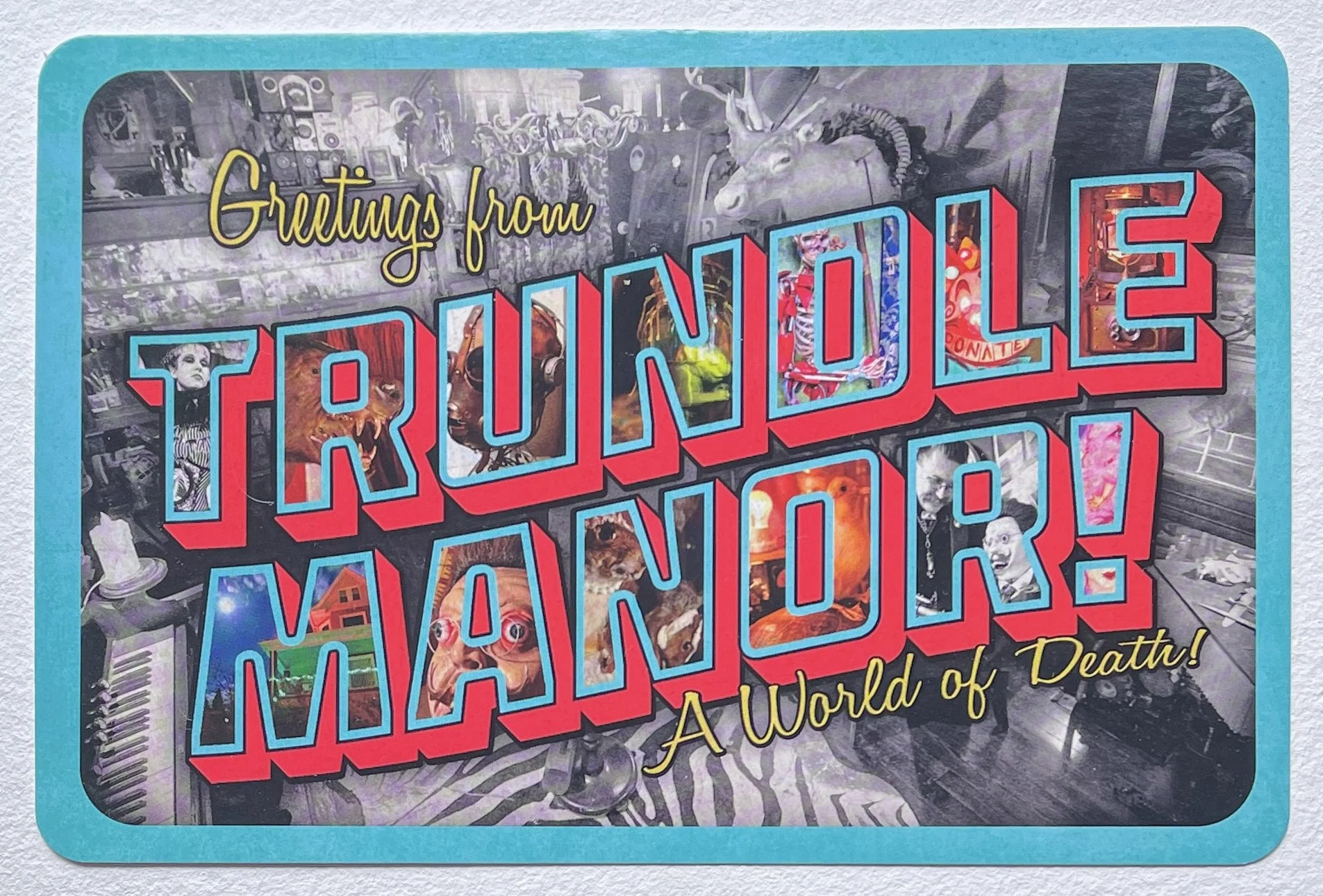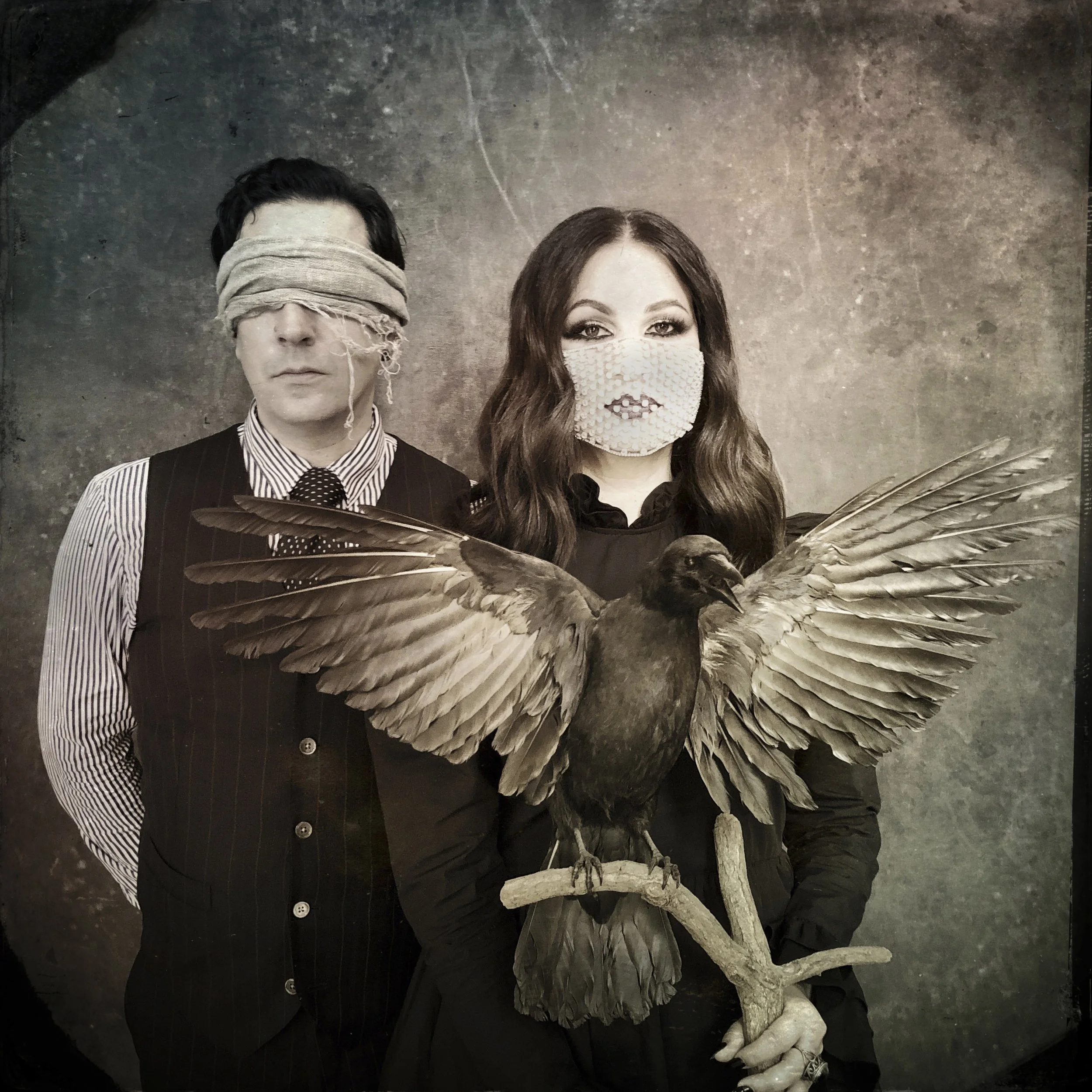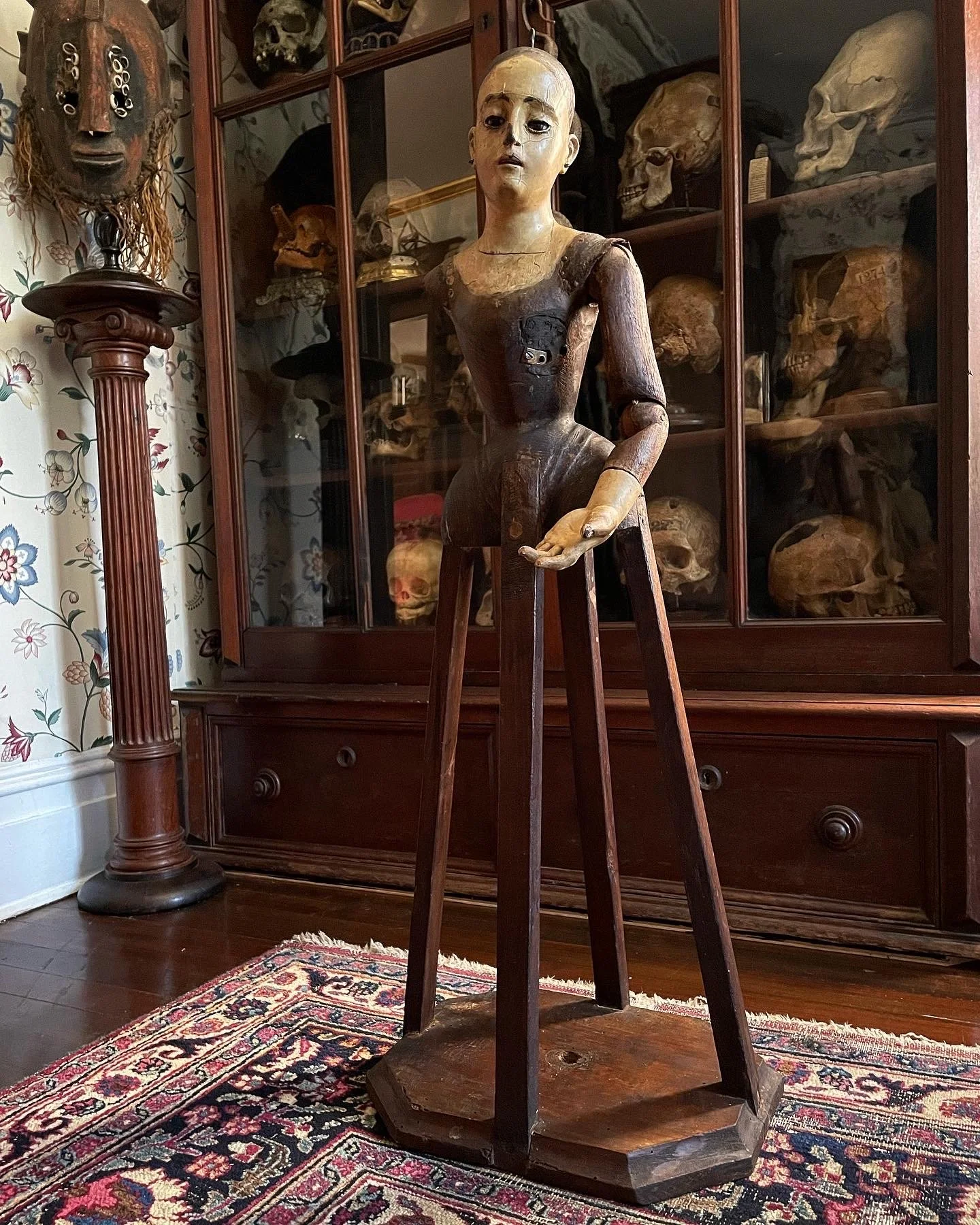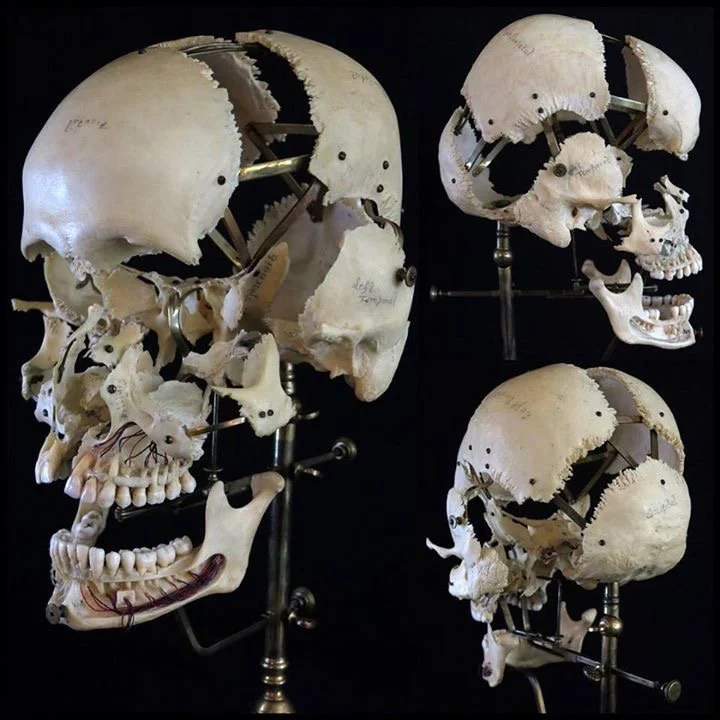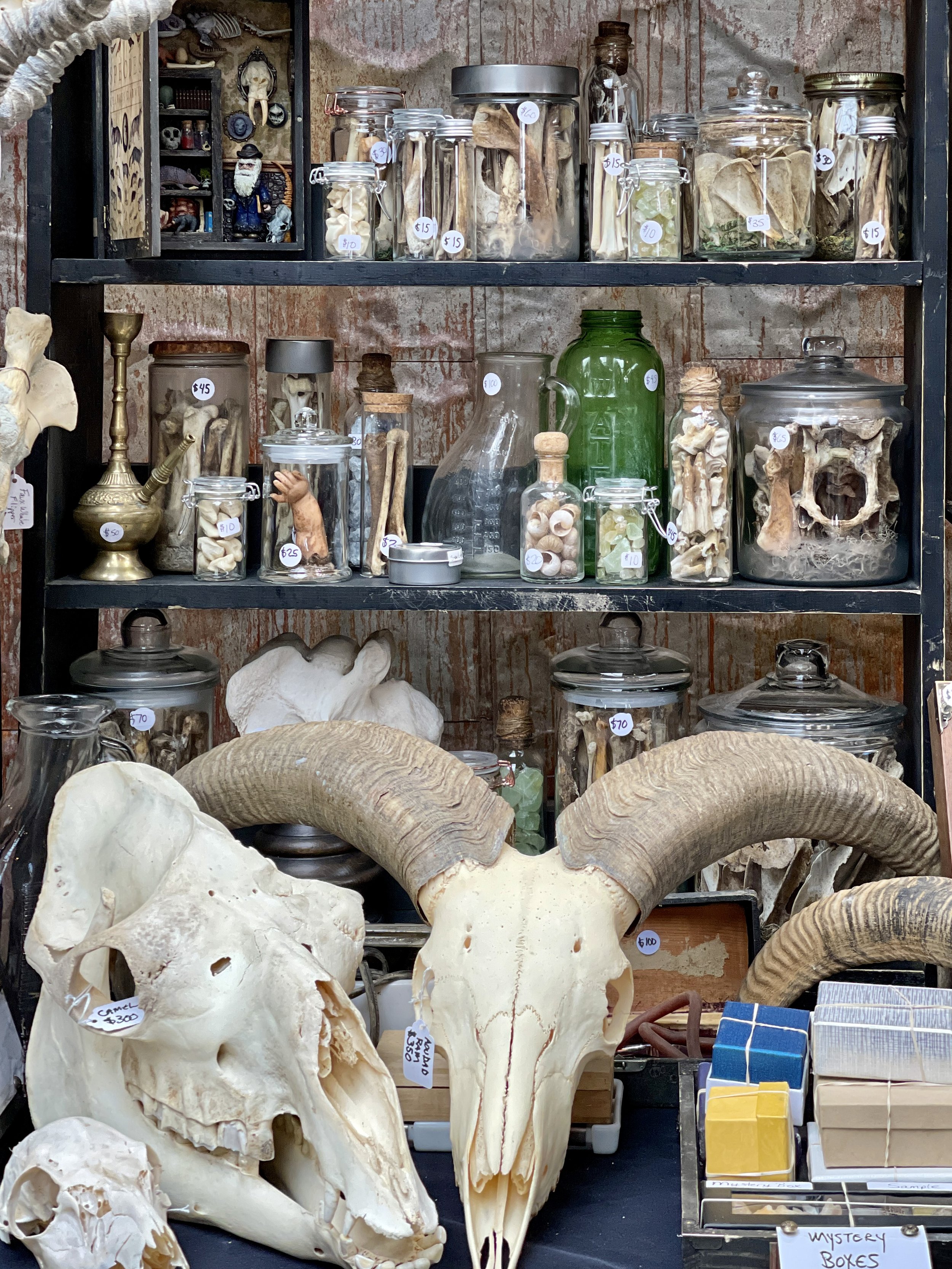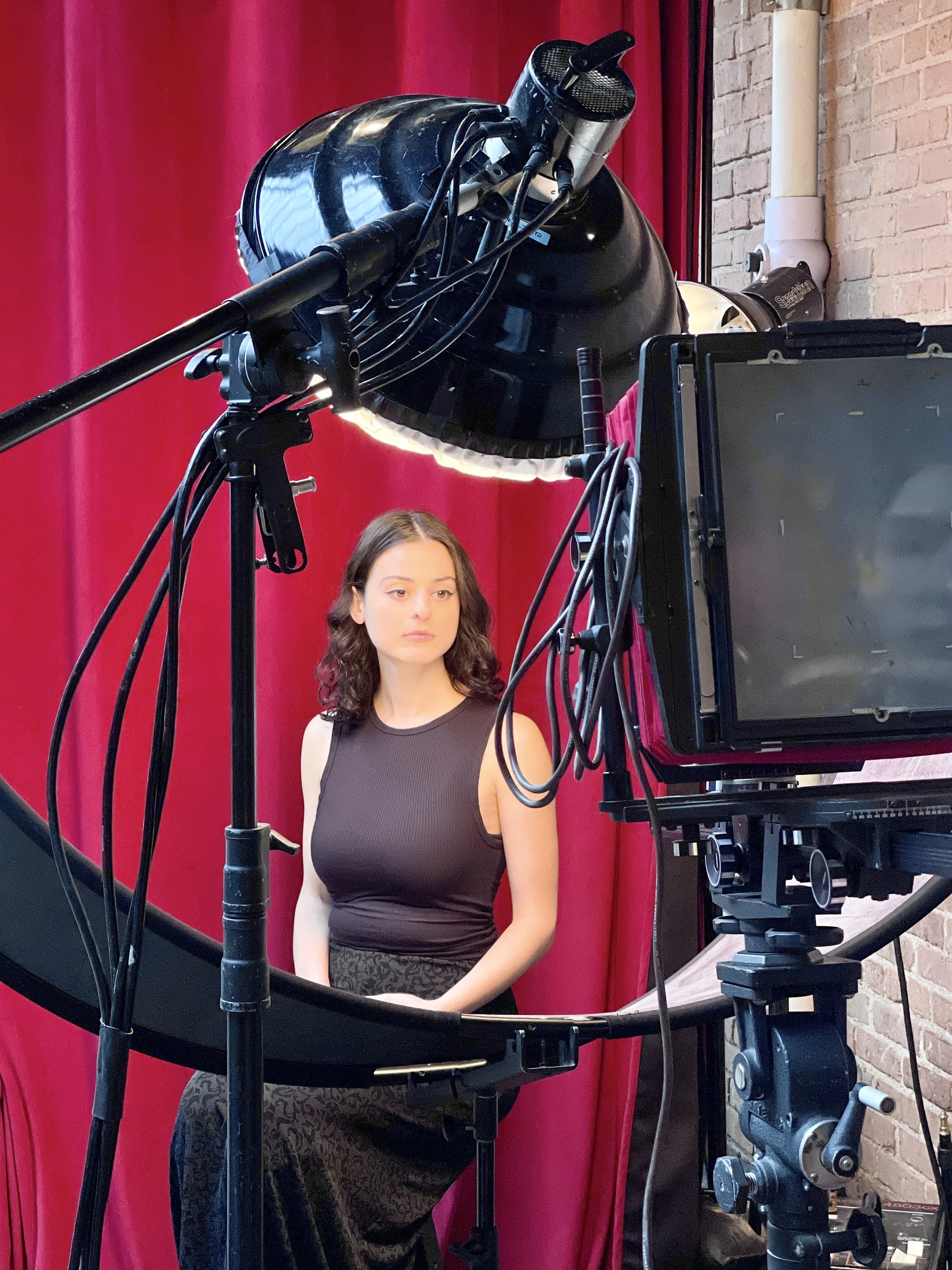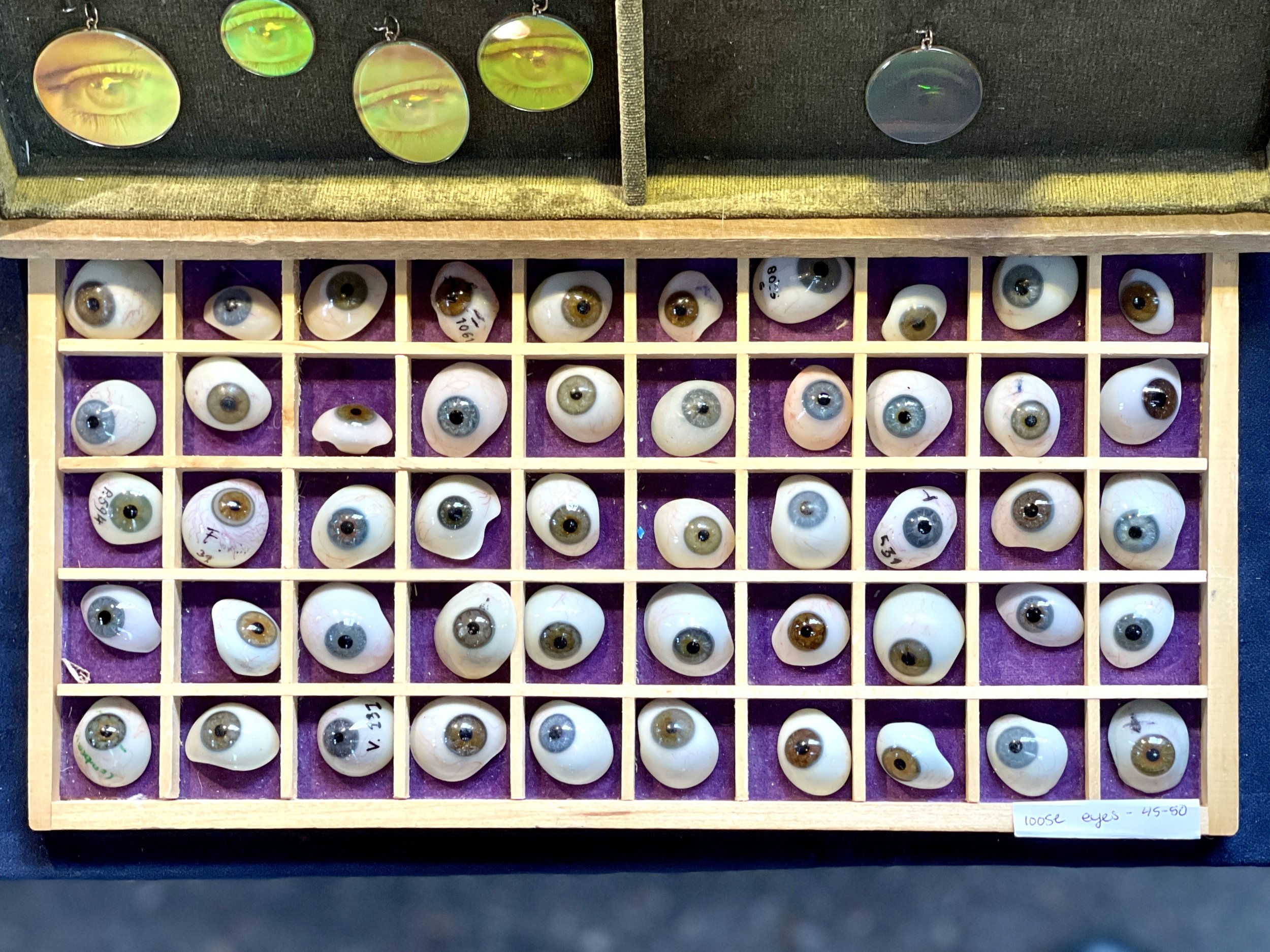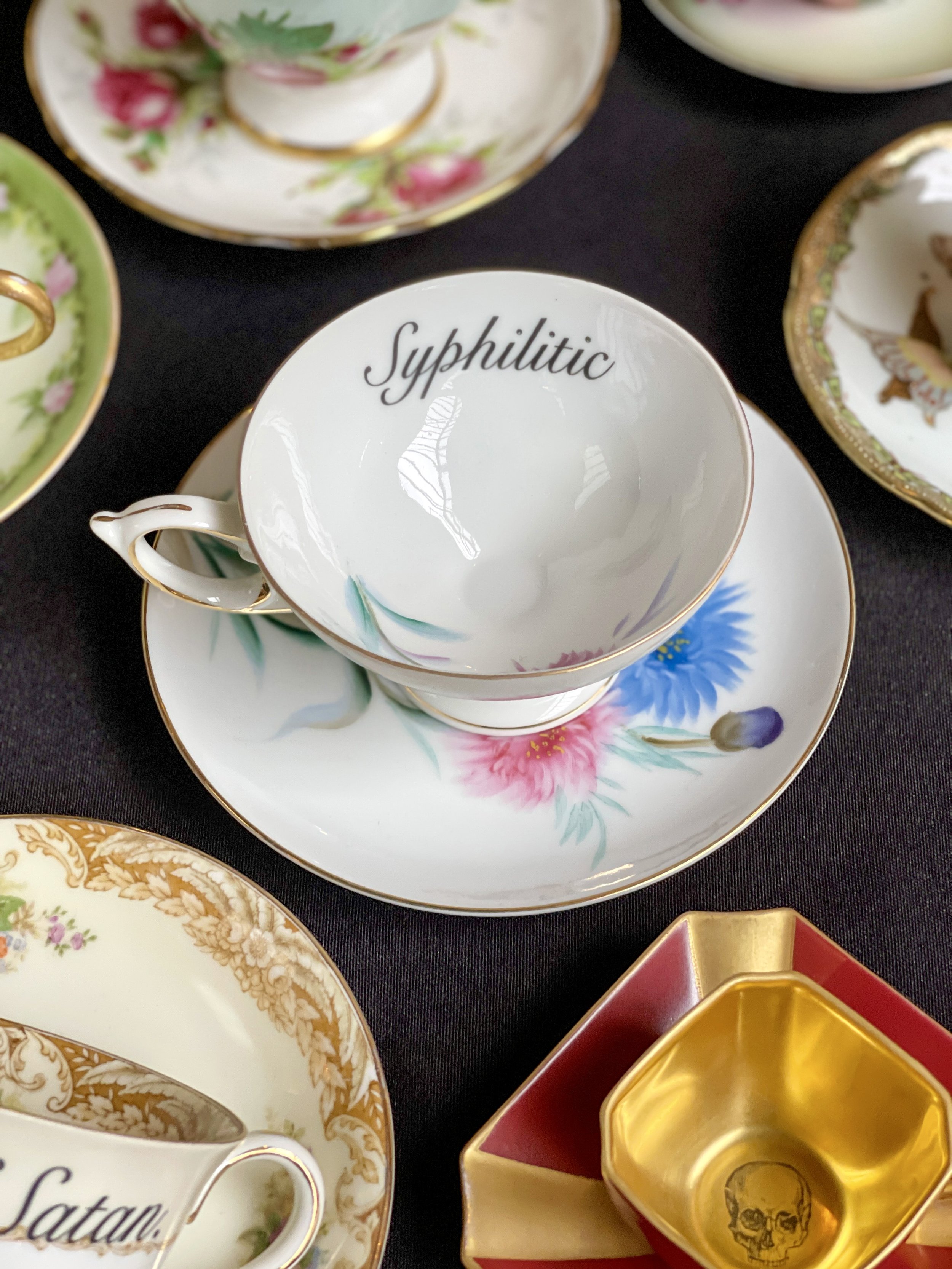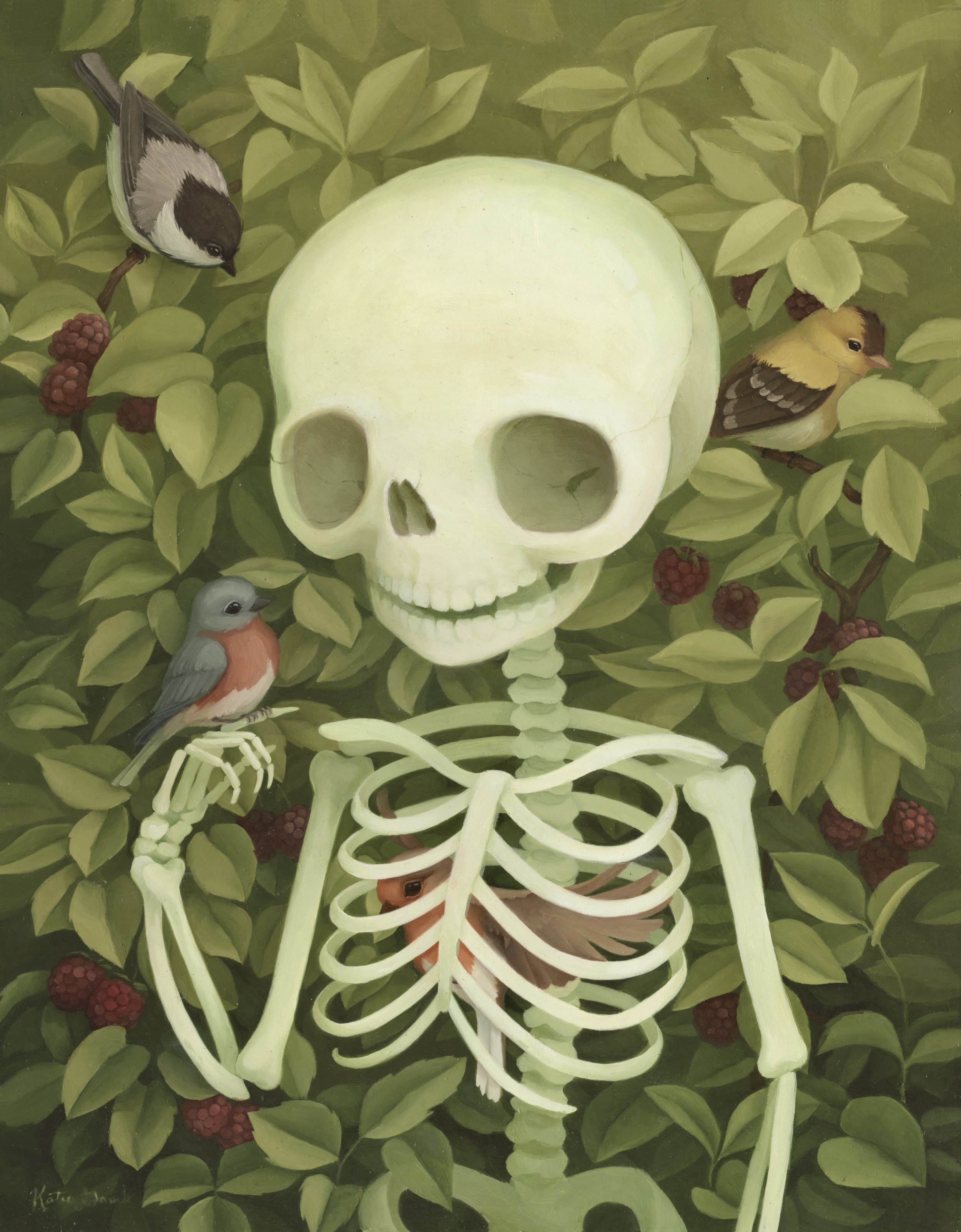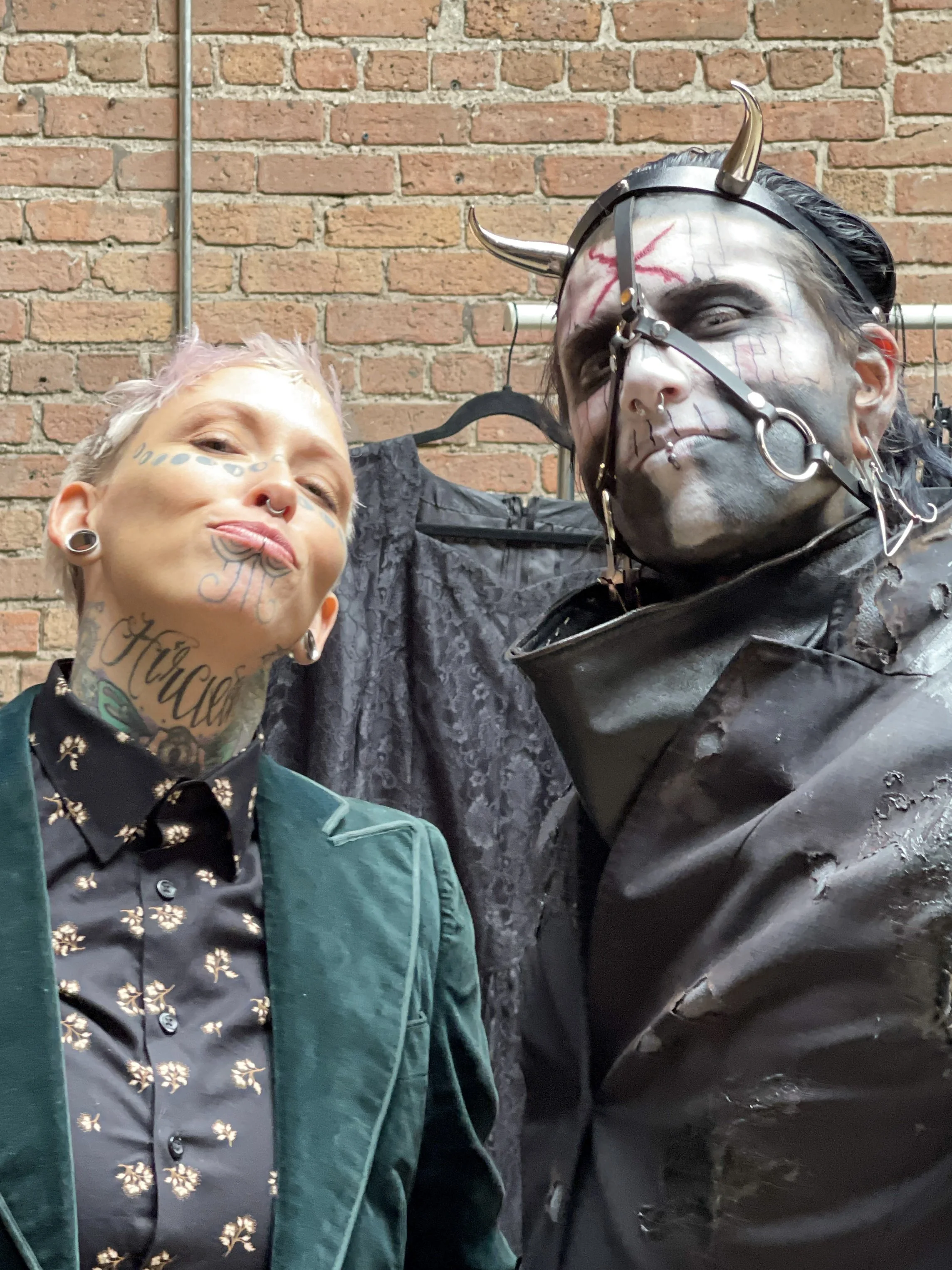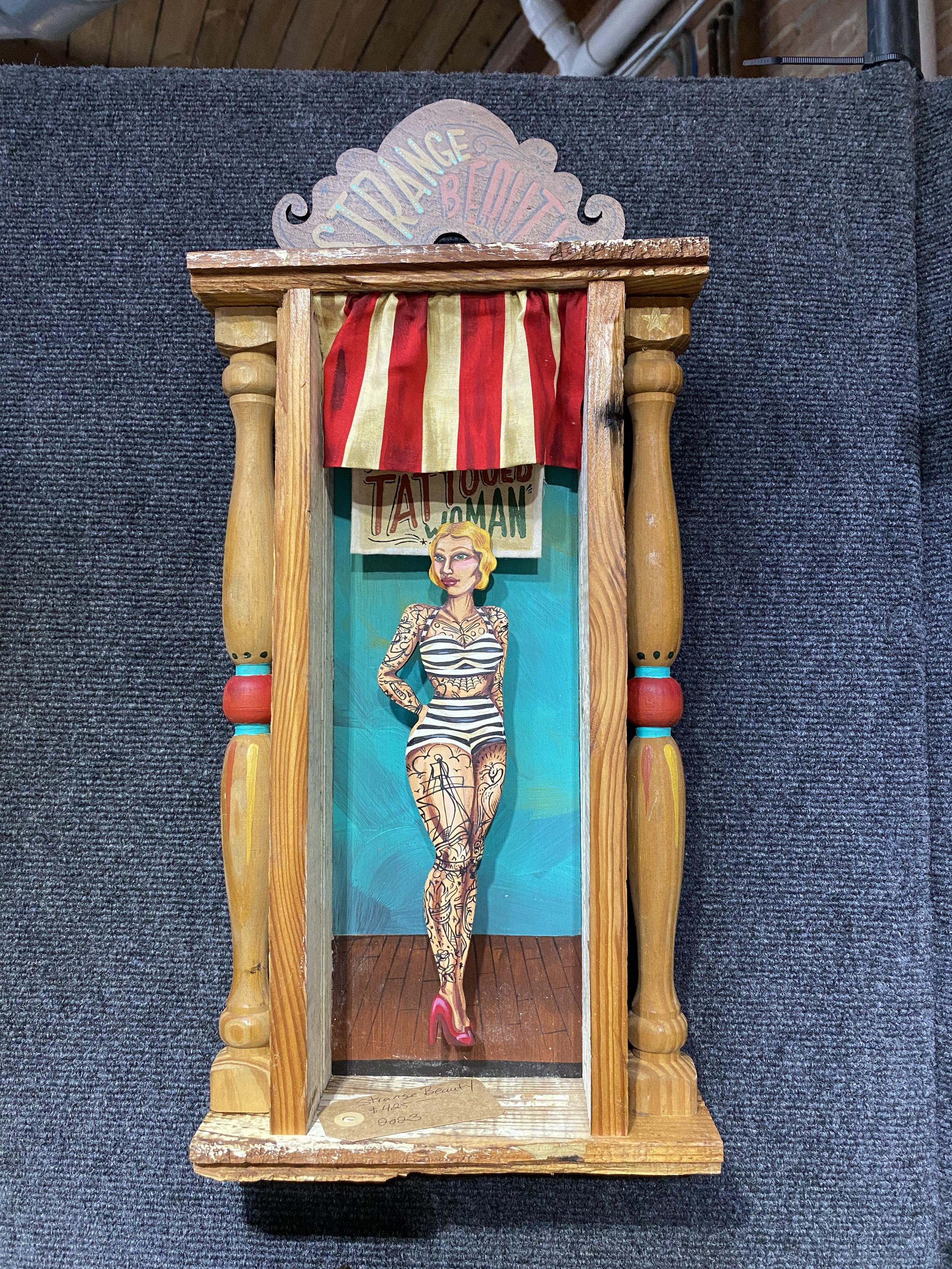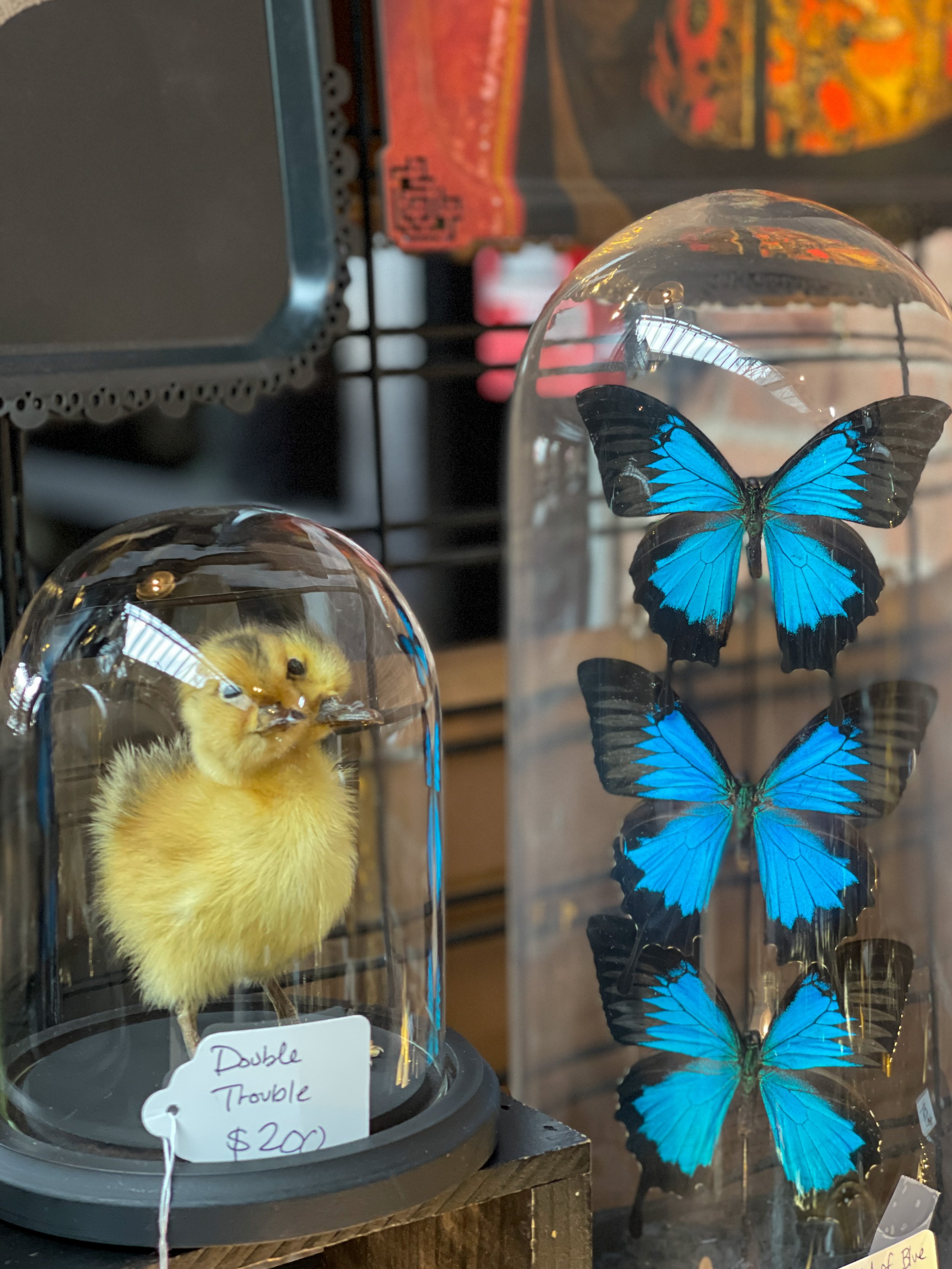Dive into a world of roadside oddities, taxidermy curiosities, cult memorabilia and chilling true crime tales — including the legacies of Ed Gein and John Wayne Gacy — at Graveface Museum.
The devil’s in the details: the iconic entrance to the Graveface Museum
If your idea of the perfect afternoon includes taxidermied animals, Church of Satan memorabilia, paintings made by a serial killer, and an arcade filled with vintage monster-themed pinball machines, then the Graveface Museum might just be your new happy place. Tucked away in Savannah, Georgia’s historic Byck building along the cobblestoned Factors Walk, this one-of-a-kind museum is a must-visit for enthusiasts of the macabre, the mysterious and the downright bizarre.
Originally, Duke and I had planned a day trip to Savannah with my mom, but she decided to sit this one out due to the blustery, cold winter weather. With just the two of us making the trip, we decided to explore some of the city’s more unusual shops and attractions.
We took an Uber from Hilton Head, South Carolina and had the driver drop us off in the artsy Starland district. It was here among the shops that we stumbled upon Graveface Records & Curiosities, a combination vinyl and oddities shop founded by Ryan Graveface — a musician, record label owner and lifelong collector of all things peculiar. (Something tells me he would get along well with Ryan and Regina Cohn, whom we’ve dubbed the King and Queen of Oddities.)
After exploring the Starland district and other aspects of quirky Savannah, we made our way to Bay Street. The Graveface Museum is tucked away in the historic Byck building at 420 East Factors Walk, a cobblestone thoroughfare sandwiched between River Street and Bay Street. Keep an eye out: This hidden gem isn’t as obvious as the tourist stops along the river — but that only adds to its allure.
The museum pays homage to all things creepy or unusual.
A Grave Undertaking
The museum opened in February 2020 (right before the pandemic hit, gulp) as a passion-project-turned-immersive-experience. Given that Ryan’s last name is Graveface, an affinity for the macabre seems inevitable. With a mission to preserve and showcase the stranger aspects of history, he’s curated an eclectic mix of roadside attractions, true crime artifacts, cult memorabilia and secret society paraphernalia, among other peculiarities.
Highlights include the largest private collection of John Wayne Gacy’s paintings, artifacts from Ed Gein’s notorious crimes, and exhibits on topics ranging from Satanism to UFO cults. The museum also features a free pinball arcade, offering visitors a chance to unwind after exploring its darker displays.
The eclectic gift shop
Enter Through the Gift Shop
Your journey into the macabre begins in a gift shop that’s as offbeat as the museum itself. Part retail space, part curiosity cabinet, it’s stocked with horror-themed merchandise, oddities and hilariously gory painted movie posters from Ghana, Africa. It’s an appetizer for the weirdness that lies ahead.
Sunny days…with a side of terror: Ernie and Bert masks up front
The $25 entrance fee might seem a bit steep, but if you’re into all things weird, it’s worth it. The staff is brimming with enthusiasm, eager to share their knowledge of the unusual. With your ticket in hand, you’re ready to step into a world where the bizarre, the dark and the fascinating collide. Step right up — into the gaping maw of a bright red devil.
The first room of the museum houses medical oddities like the Spiderfawn.
The Tour Begins: Roadside Oddities
The first room welcomes you into a world of roadside curiosities — an homage to the kitschy, the creepy and the oddly endearing. Here, you’ll find displays of “freaks of nature”: a taxidermied faun with two heads and extra legs, and Clementine, a calf with five legs — a mix of biology gone awry and human fascination with the unnatural.
But not everything is what it seems. This room dives into the art of Homer Tate, nicknamed the “King of Gaffes” for devising grotesque, cobbled-together creations that once dazzled and duped carnival-goers, including a few variations of the infamous Fiji mermaid. Our favorite was the one called Fish Girl, which incorporated the red hair of Tate’s wife and a cat’s teeth.
This Fiji mermaid is a hoax by Homer Tate, who used his wife’s hair and his cat’s teeth.
Apparently, Tate also produced shrunken heads — some fake, some real! — and was arrested for grave robbing. However, since he was the town sheriff, he didn’t spend have to worry about spending time behind bars.
Also in this first room are dioramas of taxidermied critters that reveal a peculiar Victorian obsession: crafting miniature scenes featuring preserved animals in quirky, anthropomorphic roles. These whimsical displays, once popular showpieces for the 19th century elite, straddle the line between charming and unsettling. Our favorite? A tiny circus featuring prematurely born kittens as the star performers — walking the tightrope, balancing on balls and delighting an imaginary crowd. What else would you expect from the generation that created death photography?
RELATED: See this roadside oddity in Pittsburgh, Pennsylvania
Cute l’il Clementine was born with five legs. You can see the purple mirrored chamber about Heaven’s Gate and alien abductions.
Alien Abductions and Heaven’s Gate
From roadside oddities, you’re transported into a small, mirrored room that feels like stepping into another dimension. This space is dedicated to UFO lore, alien abductions, and one of the most infamous cults of modern times: Heaven’s Gate. A video loop of its founder anchors the exhibit and offers a chilling glimpse into the cult, whose members believed they would ascend to an alien spacecraft trailing the Hale-Bopp comet.
The room’s mirrors amplify the eerie vibe, reflecting the otherworldly artifacts and making you feel like you’ve entered a cosmic echo chamber.
The mannequin on the right is of Anton LaVey, who founded the Church of Satan.
Satanism and Secret Societies
The next stop on our journey delved into the forbidden, the misunderstood and the hidden corners of belief systems.
One room is dedicated to Satanism, with a focus on the Church of Satan and its theatrical founder, Anton LaVey, whose philosophy challenged societal norms and fueled decades of controversy. Sexual liberation played a major part in LaVey’s teachings, and he encouraged members to embrace it. LaVey contended that living in a society in which we repress our natural urges and instincts results in unhappiness.
From there, we entered a room dedicated to Christianity and secret societies like the international Order of Oddfellows. Artifacts from these groups reveal a fascinating interplay between faith, ritual and mystery.
The juxtaposition of these belief systems — one often feared and the other foundational to Western culture — invites you to ponder the fine line between the sacred and the profane.
Stop and play some pinball to prep yourself for a (serial) killer ending.
The Pinball Arcade
Just when the heavy, dark vibe starts to settle in, the museum offers a much-needed breather: a room filled with vintage pinball machines. It’s a welcome shift in atmosphere, adding a playful, nostalgic charm to the experience.
Of course the lineup features creepy classics like The Addams Family, Dracula, and Halloween, a perfect nod to the museum’s macabre aesthetic. Best of all? These machines are free to play. Whether you’re a seasoned pinball wizard or just looking for a moment to decompress, this quirky arcade is the perfect palate cleanser before diving back into the dark history waiting around the corner.
This macabre display is a re-creation of Ed Gein’s final murder, where he decapitated a woman’s head and mutilated her genitals.
Haunted House: Ed Gein’s World
From pinball nostalgia, you’re thrust into the unsettling world of Ed Gein, aka the “Butcher of Plainfield” — a man whose gruesome crimes blurred the line between true crime and urban legend. The guided tour through Gein’s macabre legacy busts some of the myths that have grown around his name. No, there weren’t lampshades made of human skin or a “nipple belt.” (Gein didn’t even have electricity, and that infamous accessory was a hoax made out of latex.) But yes, he really did use skin to upholster the seat of a chair, and he carried around a nifty keychain made from a piece of his mom’s scalp and hair.
Ed Gein inspired numerous villains in horror movies, including Psycho, The Silence of the Lambs and The Texas Chain Saw Massacre.
Gein, who robbed graves and murdered two women, is the inspiration for countless fictional killers, from Norman Bates to Buffalo Bill and Leatherface. The exhibit doesn’t flinch in showing the grisly details, including a diorama of his final victim. She’s depicted hanging upside down, her head cut off, and her genitals mutilated, revealing the true depravity of his crimes. This was to me the most disturbing aspect of the museum.
We followed our guide up a staircase lined with grisly black and white crime scene photos of mob hits that reminded me of the work of Weegee.
And yet, as shocking as it all is, there’s something oddly captivating about Gein himself. The small town simpleton obviously had horrific hidden depths.
John Wayne Gacy dressed up like a clown…when he wasn’t torturing and murdering young men and boys.
Upstairs: John Wayne Gacy’s Disturbing Legacy
Climbing the stairs to the section dedicated to John Wayne Gacy, the infamous “Killer Clown,” felt like stepping into an even darker realm of horror. In this room, our guide, her tuna fish can earrings jangling as she spoke, recounted the grim tale of Gacy. He was a seemingly ordinary married man from suburban Norwood, Illinois, who, during the 1970s, tortured, sexually assaulted and murdered (not necessarily in that order) 33 boys and young men. Gacy's preferred method of killing was strangulation, chillingly referred to as his "rope trick."
One wall of the museum is dedicated to the faces of Gacy’s known victims — a haunting tribute to the young men whose lives he stole. Seeing their photos lined up, it’s impossible not to picture the unimaginable horrors they endured.
Many of Gacy’s paintings were of the Seven Dwarves — a reflection of a childhood obsession
But what sets this room apart is the strange, surreal focus on Gacy’s art. Displayed prominently are his original paintings, including a series of the Seven Dwarves (Snow White is notably absent). Gacy’s clown paintings are equally unnerving, given his former role as a community entertainer in full clown getup.
A list of prices reveals that back in the 1990s, you could pick up a Gacy painting for a mere 100 bucks (or $270 nowadays). Today, their value has skyrocketed as collectors clamor for a piece of true crime infamy — a disquieting reminder of our society’s fascination with killers.
Keep an eye out for a documentary the Graveface gang is working on about Gacy.
Wally put his best freak on to try out to be a permanent exhibit at the Graveface Museum.
A Must-See for Oddities Enthusiasts
The Graveface Museum isn’t for the faint of heart — if you’re squeamish or prefer your history without a macabre twist, it’s best to give this one a pass. But for those intrigued by the intersection of the bizarre and the dark, it promises a one-of-a-kind experience.
From taxidermied curiosities and cult artifacts to the unsettling tales of Ed Gein and John Wayne Gacy, the Graveface Museum balances horror with history, never veering into exploitation, but refusing to shy away from the unsettling truths of human nature And let’s not forget about the free pinball!
Whether you walk away fascinated, haunted or simply grateful for the ordinary comforts of your own life, one thing is certain: The Graveface Museum will stick with you long after you’ve left its eerie halls. –Wally
SEE ALSO:
The Oddities Flea Market
Death masks and other delights!
The Deets
When yoiu see Freemasons’ Hall, you’re close. Find the fittingly creepy Lower Factors Walk between Bay and River.
Location
The Graveface Museum is tucked away at 410 East Lower Factors Walk, a strange little in-between street near Savannah’s waterfront. It’s not quite street level and not quite below it, but rather a cobblestone thoroughfare sandwiched between River Street and Bay Street.
If you’re driving, nearby parking can be tricky, so plan ahead or prepare to walk a bit.
Admission
Tickets cost $25 per person, which includes access to all exhibits and the free-play pinball arcade.
Hours of Operation
Monday through Saturday: 11 a.m. to 7 p.m.
Sunday: 12 p.m. to 6 p.m.
Hours may vary, so it’s always a good idea to check their website or call ahead before visiting.
Graveface Museum
410 East Lower Factors Walk
Savannah, Georgia 31401
USA


